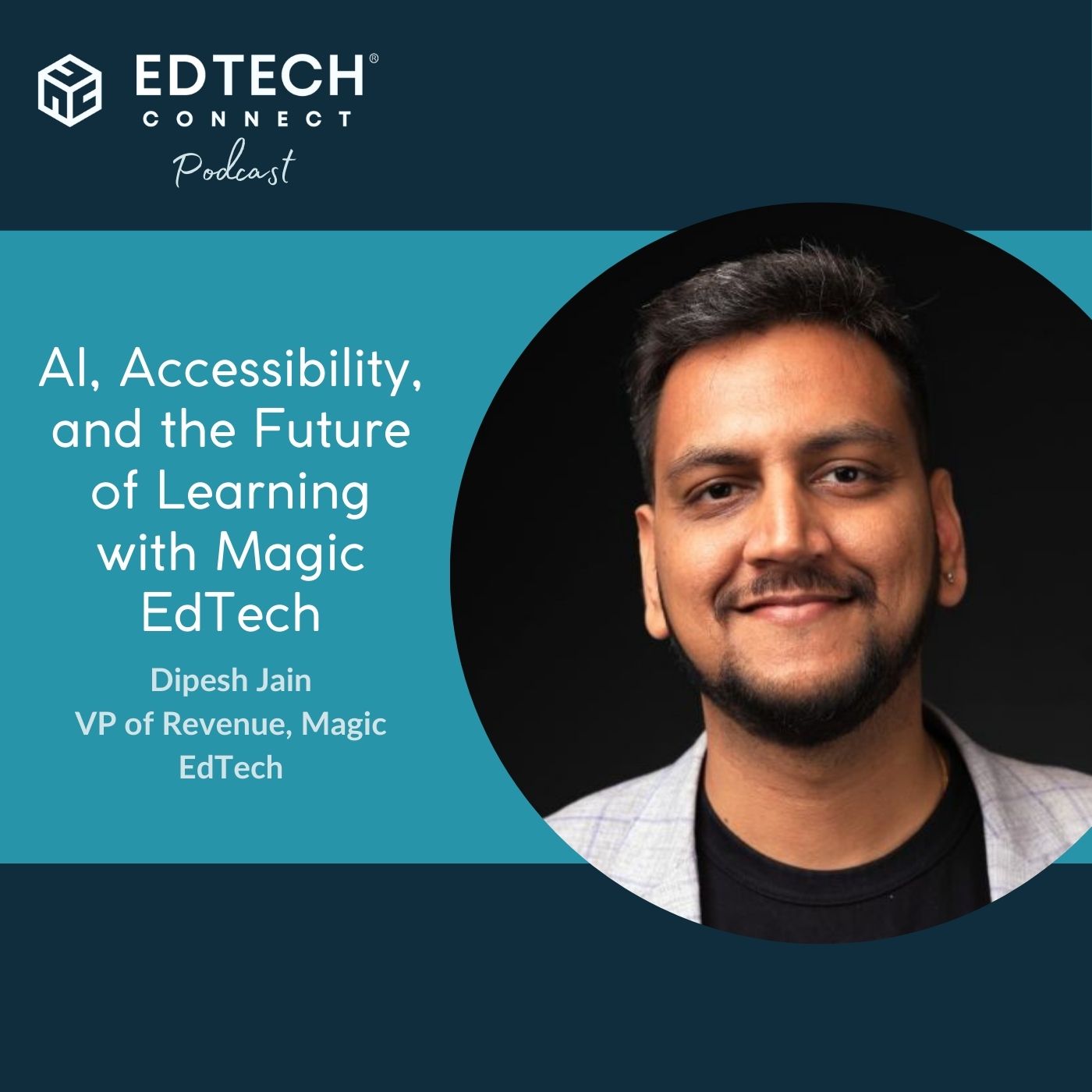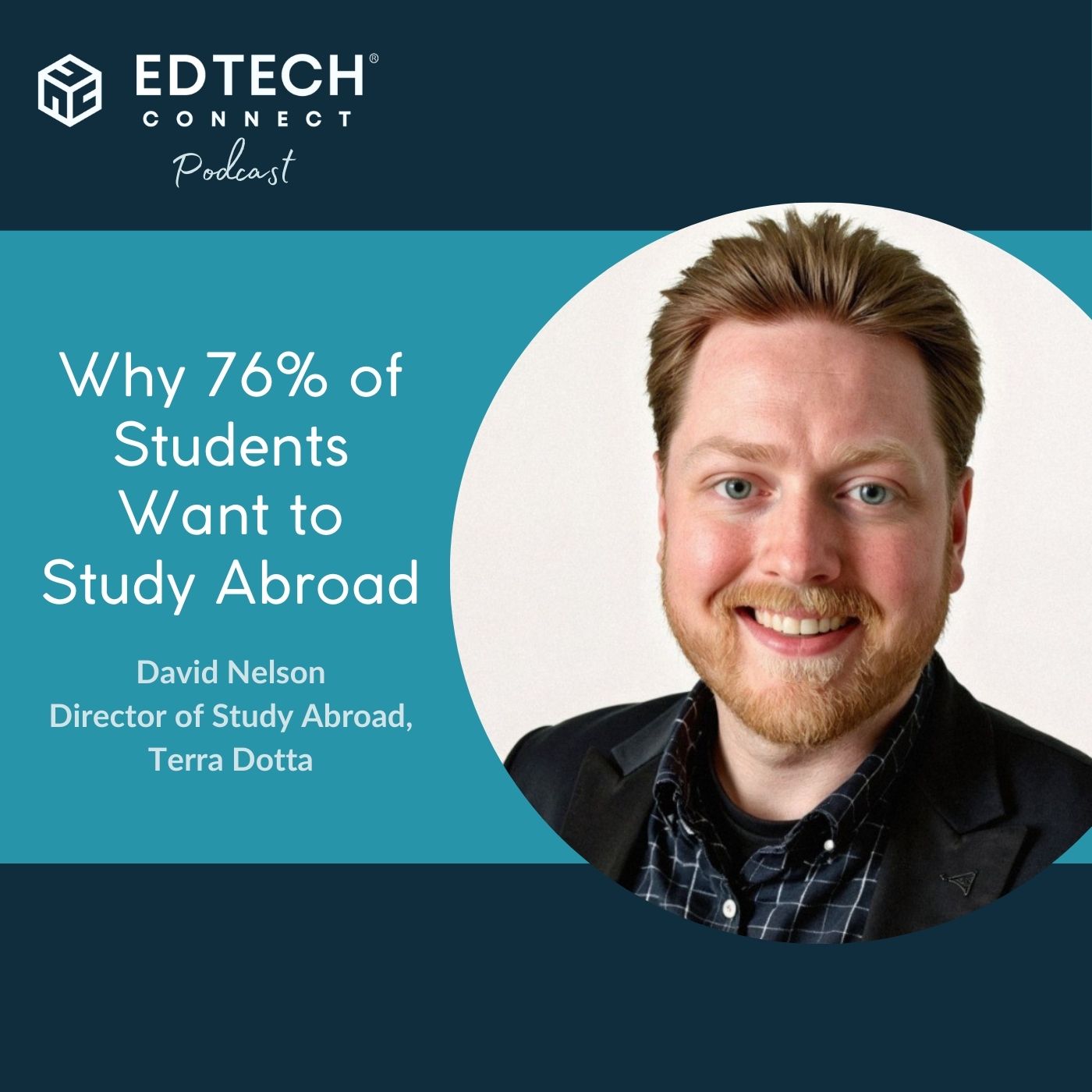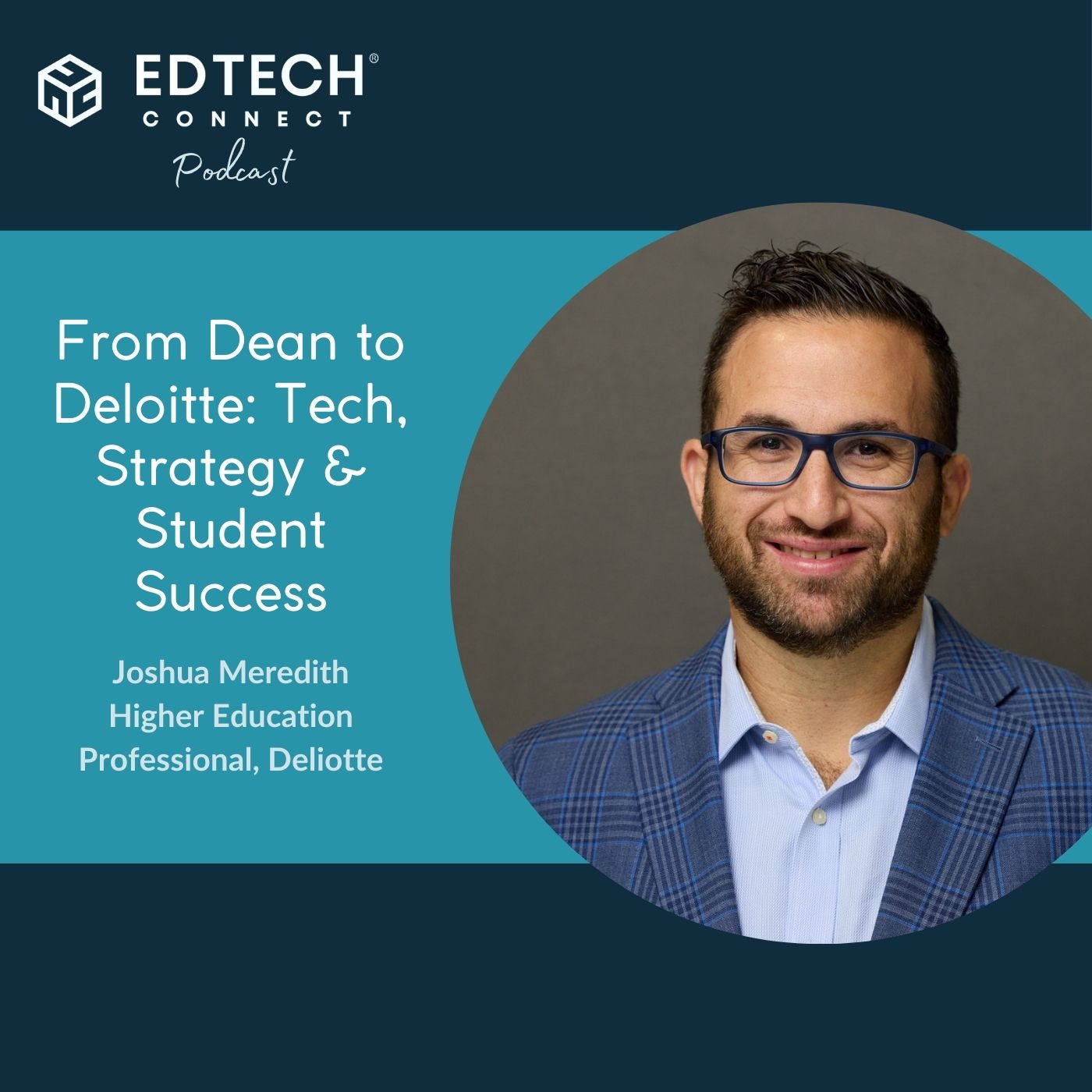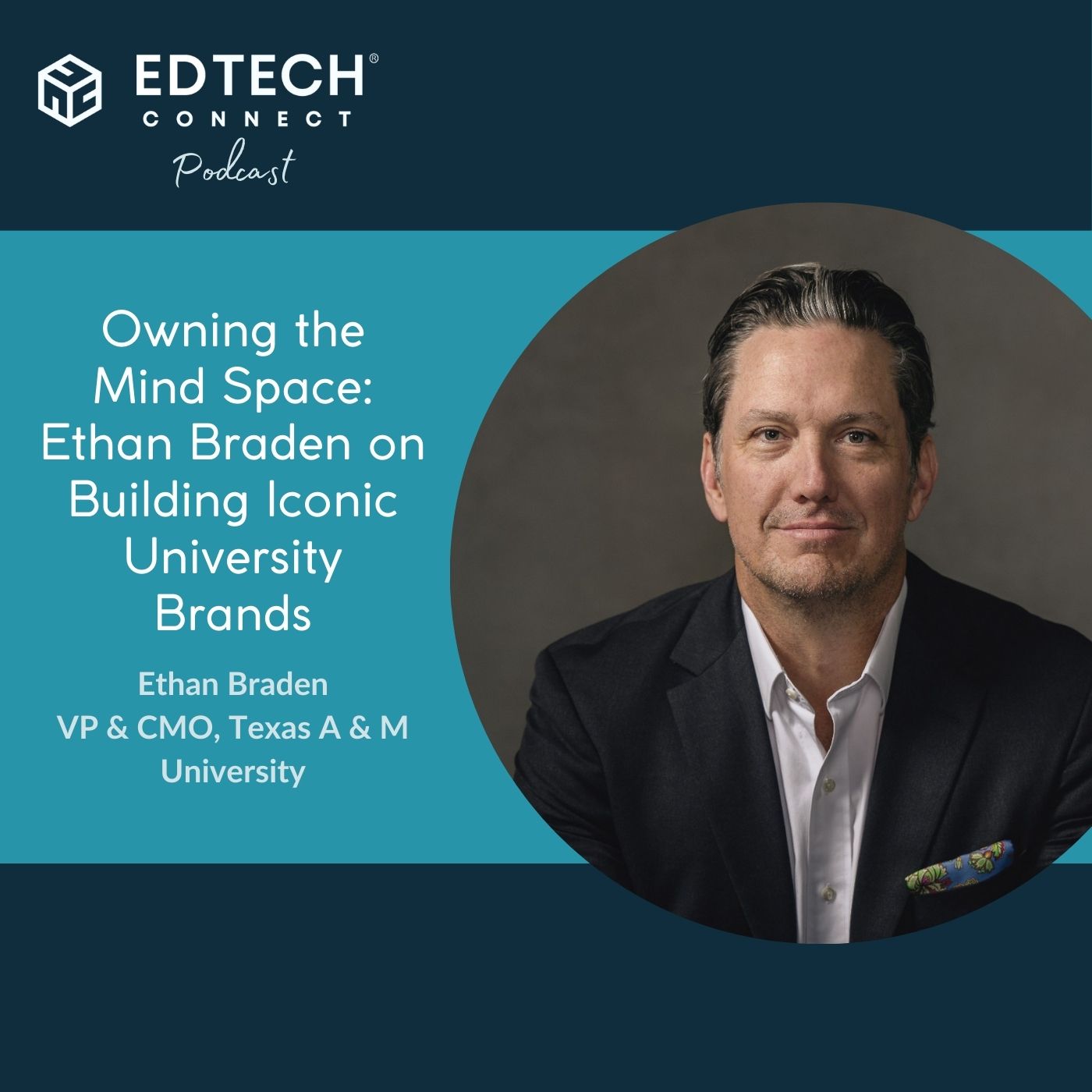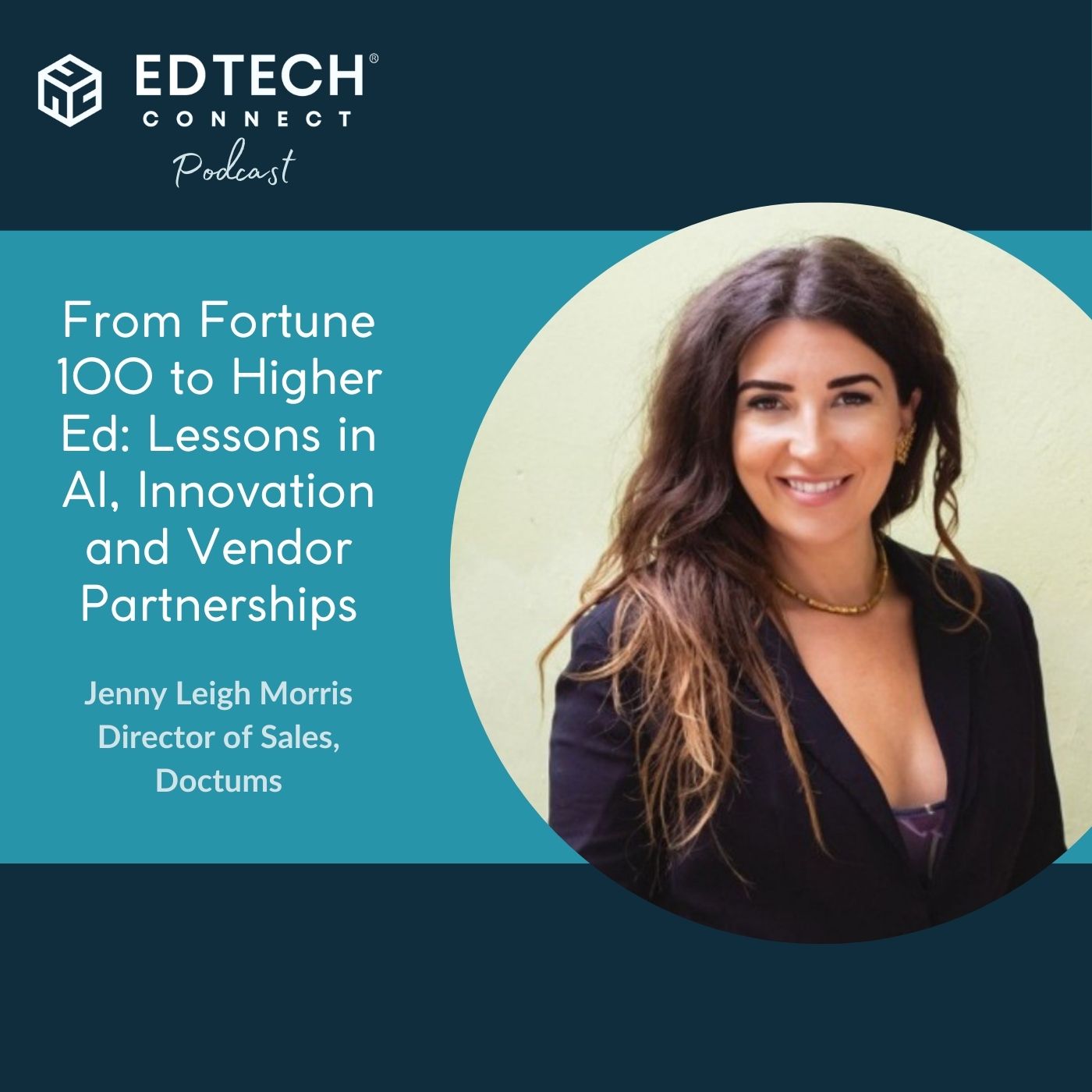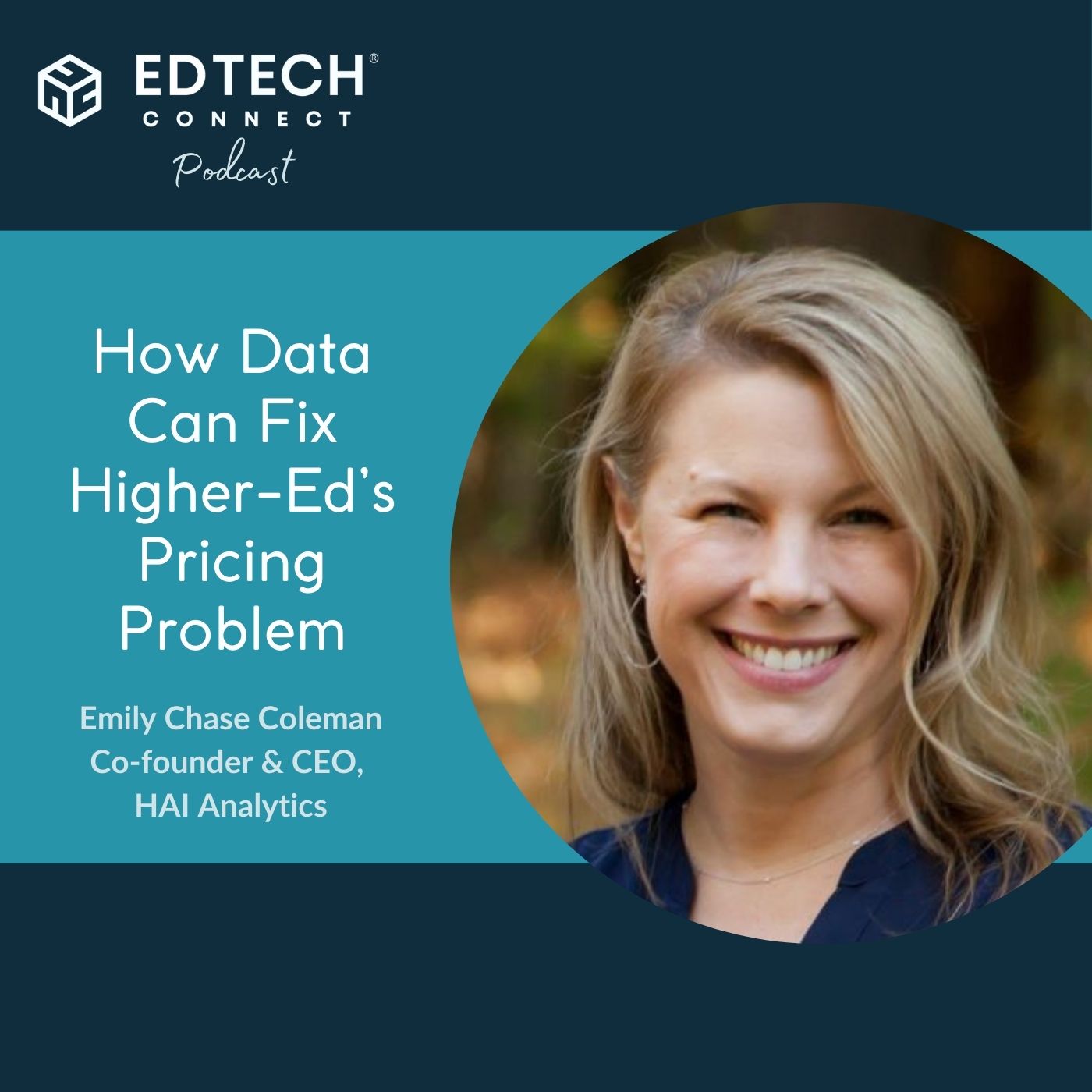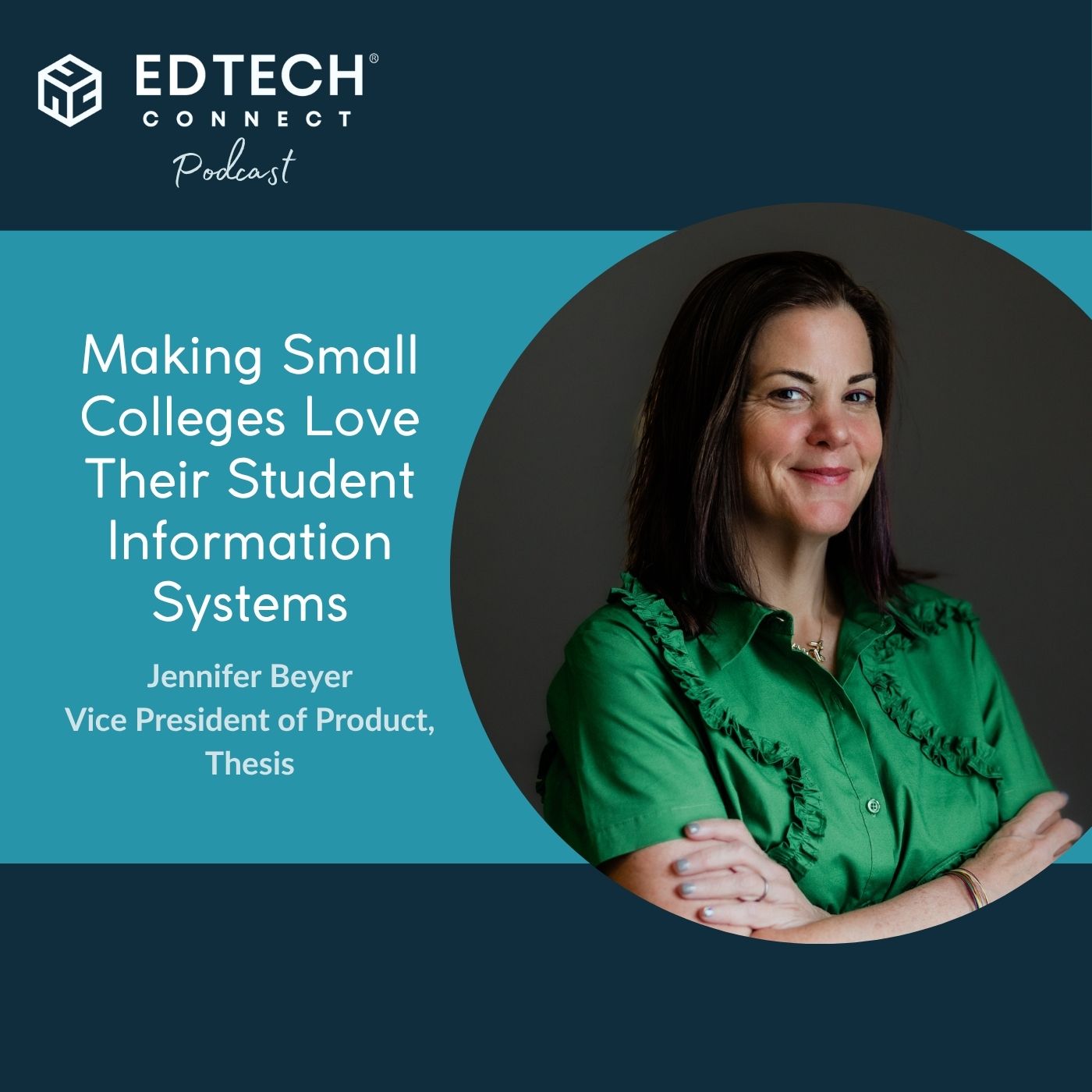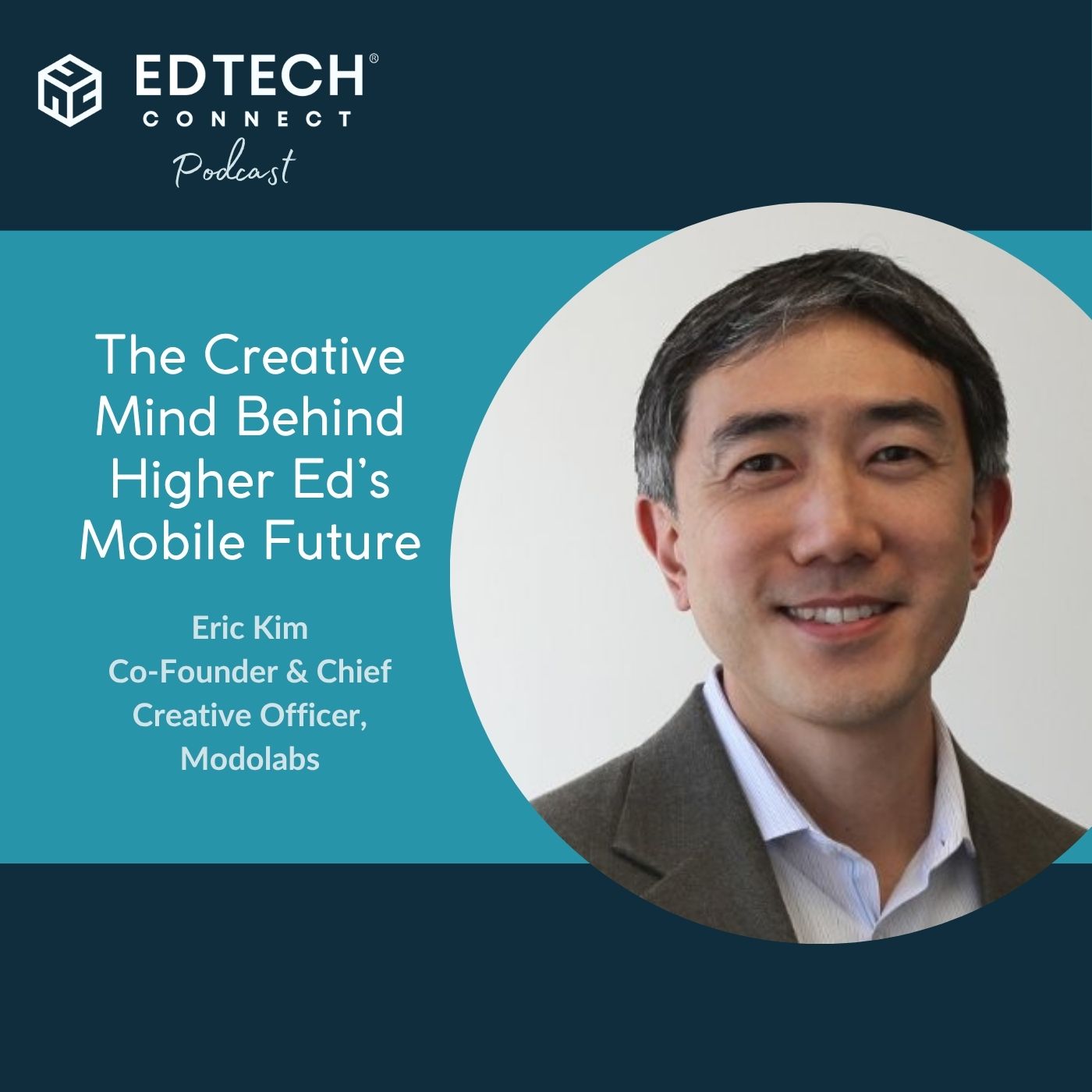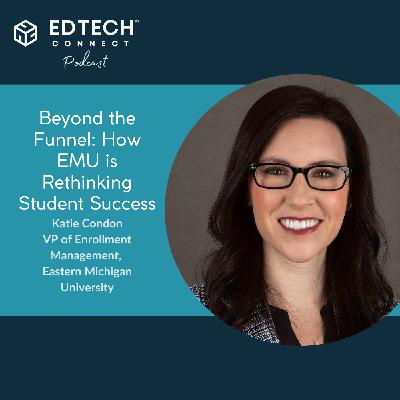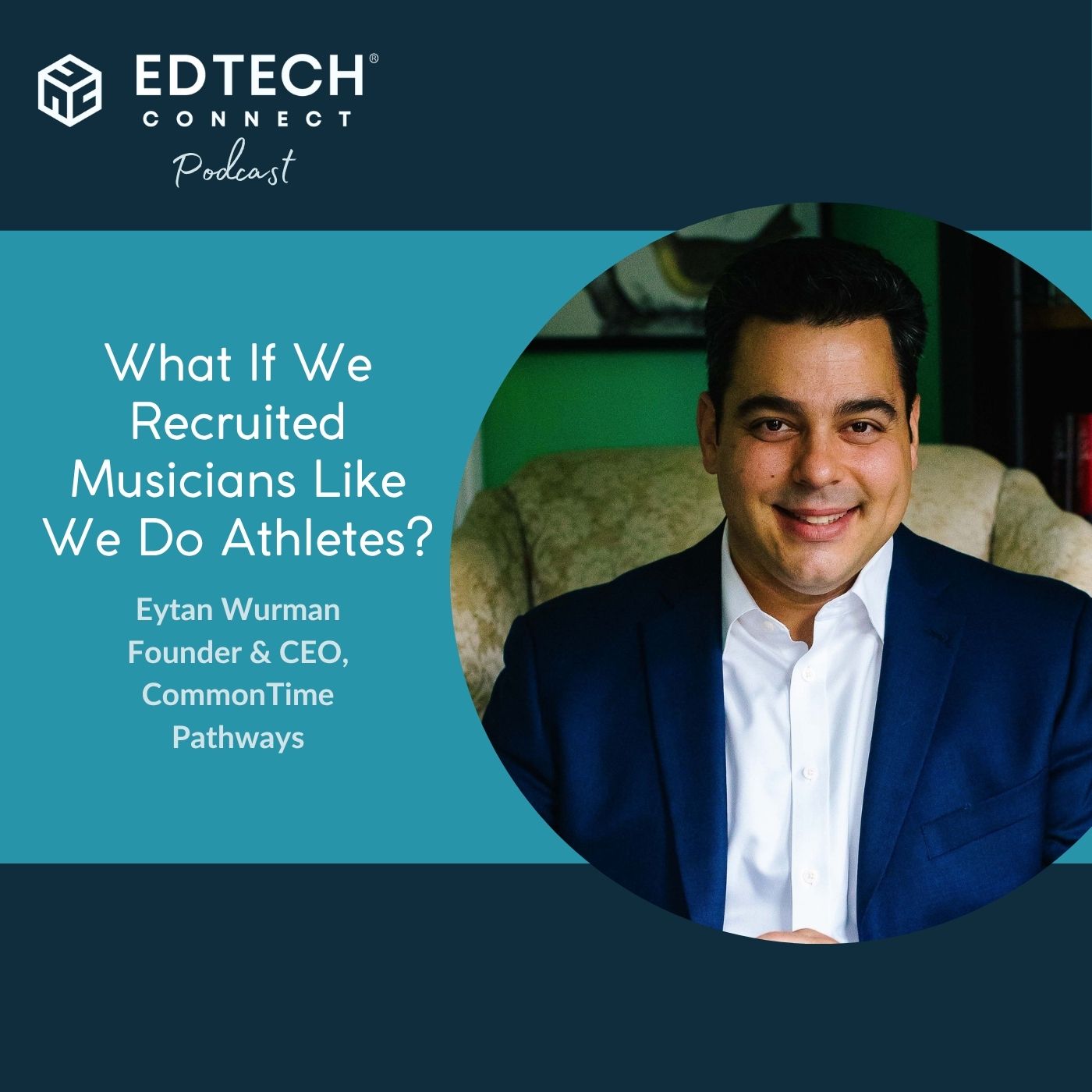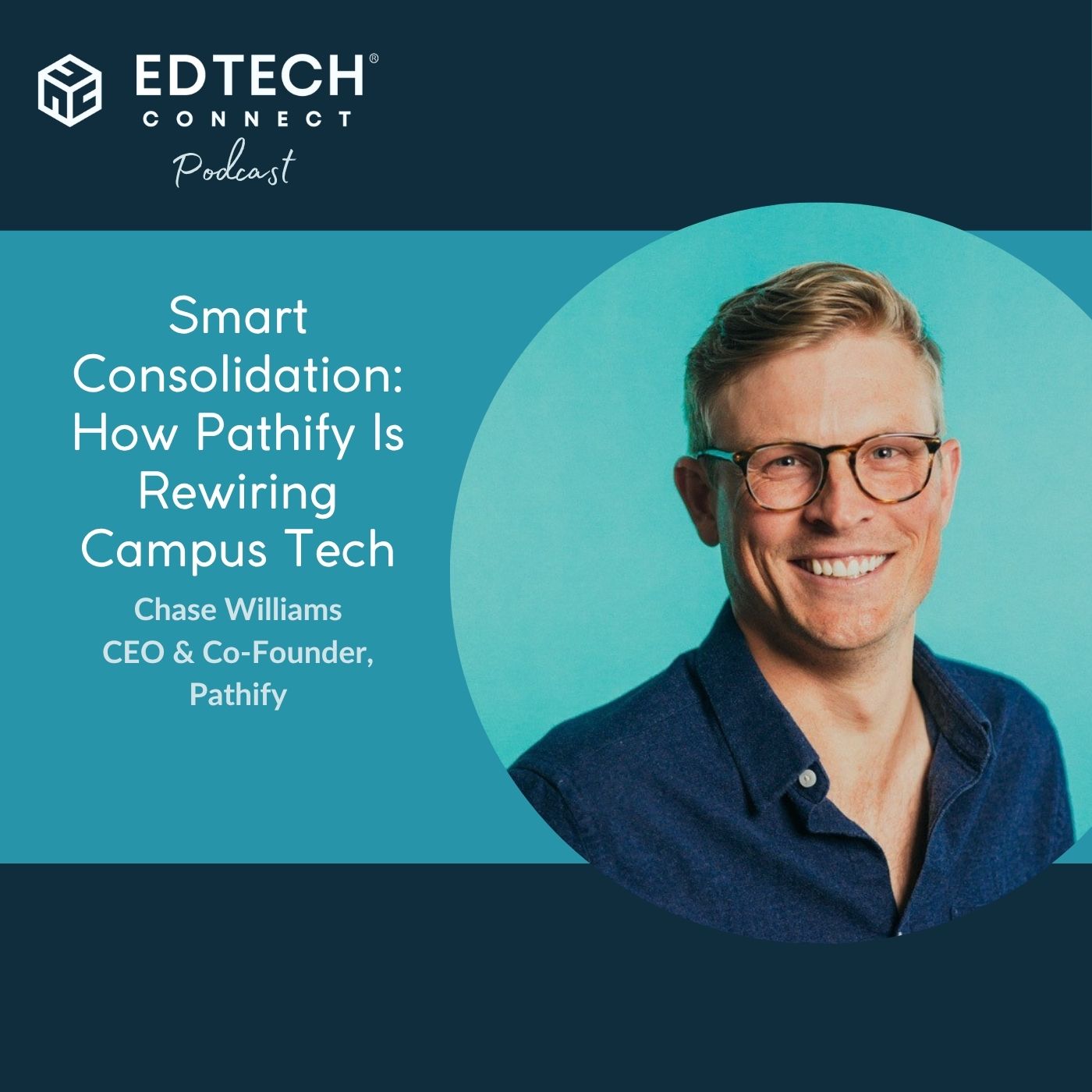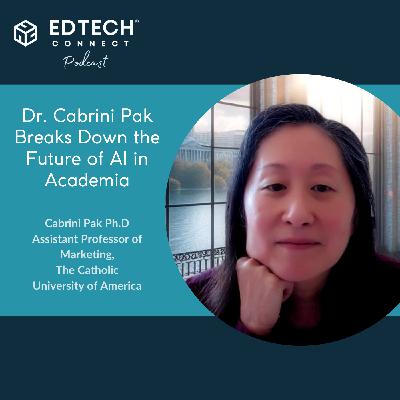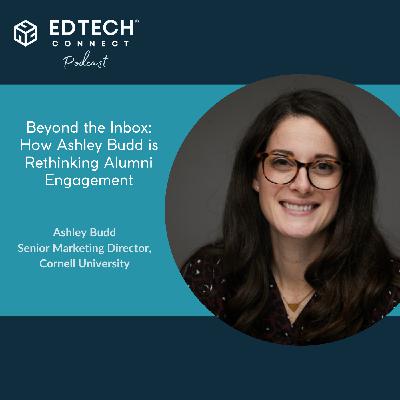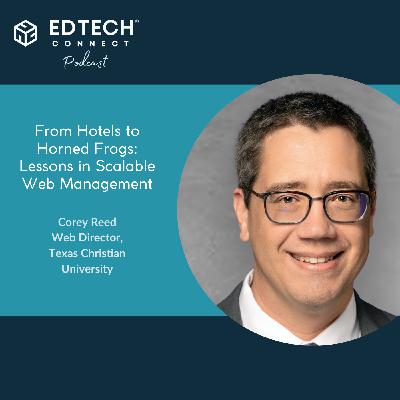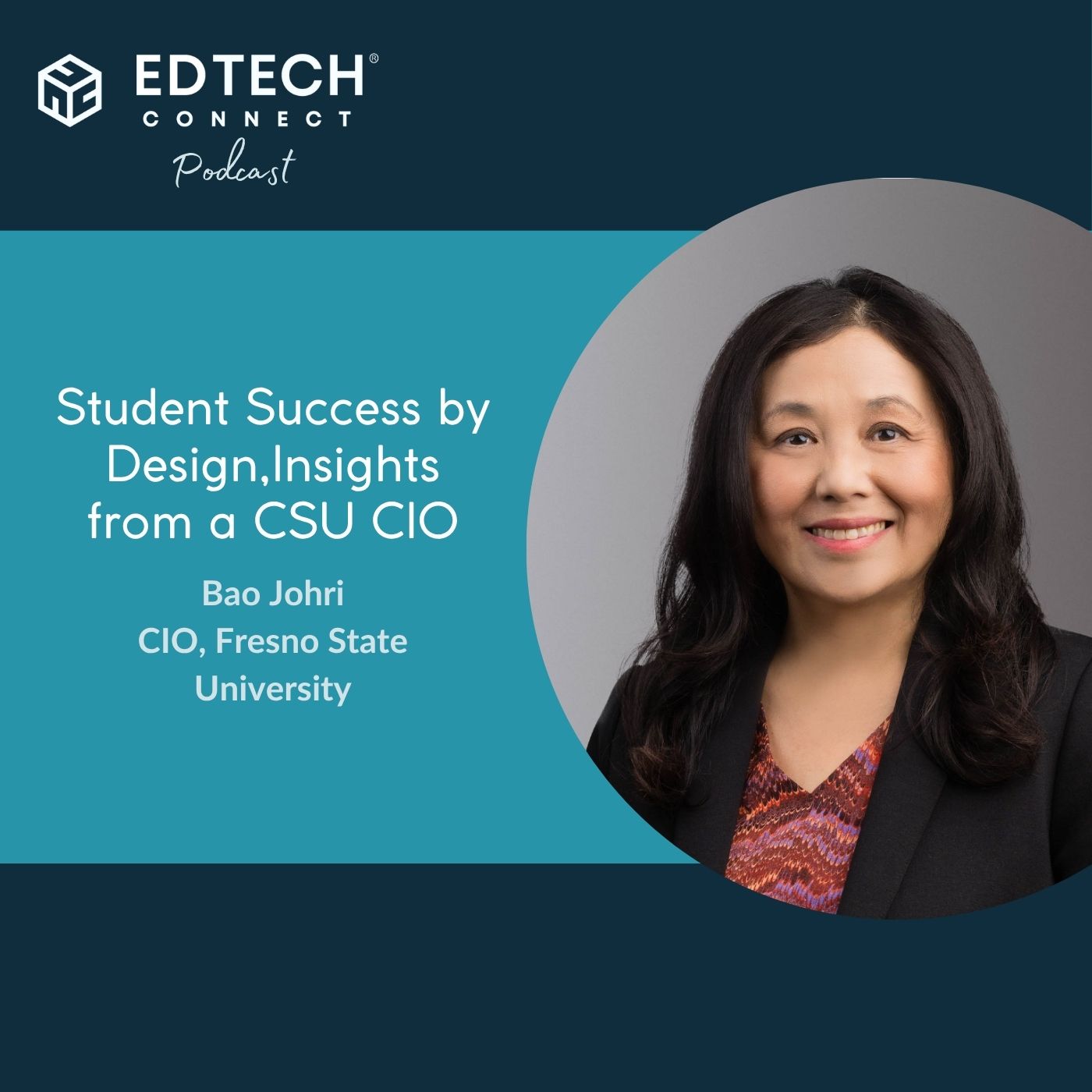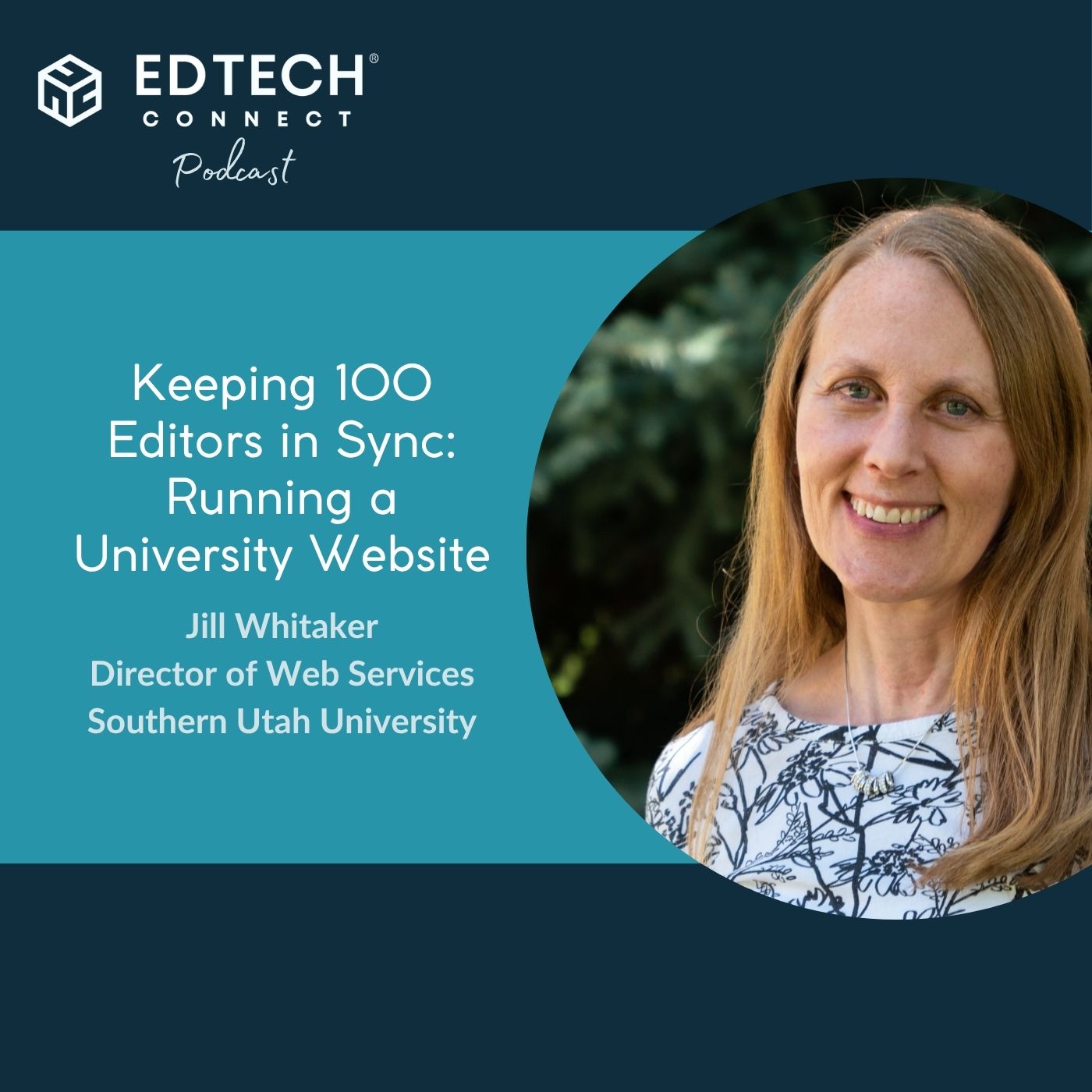Discover EdTech Connect
EdTech Connect

EdTech Connect
Author: Jeff Dillon
Subscribed: 12Played: 22Subscribe
Share
© 2024 - 2025
Description
** Reached #4 on Apple Podcast Education Category **
The EdTech Connect Podcast is the leading podcast for higher education professionals who want learn about the most innovative people and tech shaping the future of Higher Education
Join host Jeff Dillon as he explores emerging trends, pioneering developments, and real-world applications of technology in academia.
Each episode features interviews with leading experts, educators, technologists and solution providers, who share their insights on how technology can be used to improve student engagement, enhance learning outcomes, and transform the educational experience.
Whether you're a marketer, faculty, IT Leader, enrollment director, or anyone interested in the future of higher education, the EdTech Connect Podcast is your source for the knowledge and inspiration you need to harness the power of technology and drive innovation on your campus.
Listeners of the EdTech Connect Podcast will learn about the latest trends, best practices, and challenges in the rapidly evolving field of educational technology.
Learn more at https://edtechconnect.com.
The EdTech Connect Podcast is the leading podcast for higher education professionals who want learn about the most innovative people and tech shaping the future of Higher Education
Join host Jeff Dillon as he explores emerging trends, pioneering developments, and real-world applications of technology in academia.
Each episode features interviews with leading experts, educators, technologists and solution providers, who share their insights on how technology can be used to improve student engagement, enhance learning outcomes, and transform the educational experience.
Whether you're a marketer, faculty, IT Leader, enrollment director, or anyone interested in the future of higher education, the EdTech Connect Podcast is your source for the knowledge and inspiration you need to harness the power of technology and drive innovation on your campus.
Listeners of the EdTech Connect Podcast will learn about the latest trends, best practices, and challenges in the rapidly evolving field of educational technology.
Learn more at https://edtechconnect.com.
57 Episodes
Reverse
What does it take to create digital learning that is truly for everyone? In this episode of Edtech Connect, host Jeff Dillon sits down with Dipesh Jain, Vice President of Revenue at Magic EdTech, a company with a 35-year mission to make learning accessible and transformative.
Dipesh shares his unique journey from physical therapist to tech leader and how that background shapes his empathetic, partner-first approach to client relationships. They dive into the critical challenges facing education today—from boosting student retention with modern platforms to navigating the urgent demands of accessibility compliance.
Dipesh offers a clear-eyed view on implementing ethical AI that serves real student needs, not just parlor tricks, and explains how his team is making static video content interactive and on-demand. For anyone invested in the future of inclusive, global education, this conversation is a masterclass in mission-driven innovation.
Key Takeaways
Mission Over Transaction: The key to long-term partnerships (some lasting 15-20 years) is treating clients as true partners, not customers. This means acting as an extension of their team, understanding their deepest challenges with empathy, and focusing on delivering results that advance their educational mission.
Accessibility and Ethical AI are Non-Negotiable Pillars: Digital learning must be built accessibly from the start, not retrofitted later due to compliance mandates. Similarly, AI implementation in education must prioritize safety, security, and reliability over being "cutting-edge," ensuring it serves the core mission of learning without bias.
Innovation Must Be Incremental and Inclusive: Disruptive, large-scale innovation can leave learners behind. Effective change in education is slow, sequential, and designed to bring all students along, regardless of their resources or digital literacy. This ensures equity and prevents a wider digital divide.
Solve Real Friction Points, Don't Just Chase AI Hype: The best AI applications solve specific, high-friction problems in the user journey. Examples include providing 24/7 academic support for adult learners or using AI to audit and remediate content for accessibility deadlines, moving beyond "parlor tricks" to tools with substantial impact.
Understand the "Why" Behind the User: Deeply understanding the user persona—including their daily frustrations, life circumstances, and goals—is the foundation for aligning sales, marketing, and product development. This user-centric focus is crucial for creating solutions that genuinely improve engagement and retention for both traditional and non-traditional students.
AI is Making Learning Bidirectional and Personalizable at Scale: Two of AI's most transformative roles are turning passive, unidirectional content (like videos) into interactive learning experiences and finally enabling true personalization for each individual learner, a feat that was impossible to achieve at scale in a traditional classroom setting.
Find Dipesh Jain here:
LinkedIn
https://www.linkedin.com/in/dj17/
Magic Edtech
https://www.magicedtech.com/
And find EdTech Connect here:
Web: https://edtechconnect.com/
Chapters
(00:00:00) - EdTech Connect: A Wealth of Knowledge in EdTech(00:02:27) - Jeff Smith on His Diversity of Career(00:03:26) - How Magic Edtech Works With Its Customers(00:05:20) - How Magic Leap helps clients navigate the shift towards AI and accessible digital(00:08:12) - What is MagicBox(00:09:37) - In the Elevator With Universities(00:11:39) - What is Inclusivity in Education?(00:14:30) - How are we building AI into our product?(00:16:01) - How Can Tech Companies Tackle Digital Transformation Challenges?(00:17:26) - How To Align Sales and Marketing Functions(00:18:30) - WSJD.com Understanding the University Customer(00:20:15) - How has your previous experience at Tally Solutions and other companies shaped(00:21:08) - The future of digital learning(00:22:34) - Magic EdTech: Tailoring Our Strategy for International Markets(00:24:06) - What Excites and Scares You About the Future of Learning(00:25:58) - EdTech Connect
Student interest in studying abroad is at an all-time high, but so are the challenges of cost, safety, and accessibility. In this episode of Edtech Connect, host Jeff Dillon sits down with David Nelson, Director of Study Abroad at Terra Dotta and a veteran international education leader.
David breaks down the findings from Terra Dotta's latest survey, revealing why 76% of students want to study abroad and how their motivations are shifting from personal growth to resume building. They explore the "clustering effect" of social media, why students are choosing "safe" destinations like the UK, and the critical role parents play in the decision-making process.
David also shares how technology—from AI-driven data analysis to automation—is helping understaffed offices meet student expectations and make global experiences more affordable and impactful. For anyone involved in international education, this is a deep dive into the data shaping the future of study abroad.
Key Takeaways:
Student Interest is High, But Destinations are Concentrating: While 76% of students express a desire to study abroad, post-pandemic trends show them clustering in perceived "safe," English-speaking destinations (like the UK) rather than spreading out globally. This creates logistical challenges for universities and limits the diversity of experiences.
The "Why" Has Shifted from Personal to Professional Growth: Students now view study abroad primarily as a critical differentiator for their resumes and future careers in a globally competitive job market, moving beyond just the goal of personal enrichment.
Parents are a Critical (and Often Anxious) Audience: Recruitment must start as early as high school, but universities must also address the "helicopter parent" factor. Parents are a major influence and often need reassurance about safety and structure, making faculty-led programs a key selling point.
Technology is Essential for Scaling and Affordability: With tight budgets and no new staff, offices must leverage existing tech (like Microsoft Power Automate) and AI to automate processes, provide instant student communication, and use data to negotiate better, more affordable program options with providers.
AI is a Powerful Tool for Data-Driven Decision Making: AI can analyze thousands of student feedback points (surveys, emails, reviews) to perform sentiment analysis and identify program value. This allows universities to make concrete, data-backed decisions about which programs to keep, cut, or improve to better serve students.
Virtual Experiences are Bridging the Cost Gap: For students who cannot afford a traditional $10,000 program, virtual internships with major global companies (Netflix, Nike, Airbnb) offer a lower-cost alternative that still provides prestigious resume-building and professional experience.
Find David Nelson here:
LinkedIn
https://www.linkedin.com/in/denelson123/
Terra Dotta
https://terradotta.com/
And find EdTech Connect here:
Web: https://edtechconnect.com/
Chapters
(00:00:00) - EdTech Connect: David Nelson(00:01:48) - The Teradata Director of Study Abroad(00:03:21) - The Importance of Study Abroad(00:04:18) - Study Abroad: More Secure, More Global(00:06:17) - Study Abroad: Important to Personal Growth(00:08:57) - The UK remains the top student destination(00:11:15) - How to Automate Student Aid Formations(00:13:12) - Can Colleges and Institutions Improve Affordability?(00:15:14) - What's the College Student Travel Plan?(00:17:15) - Education and AI: The Future of Student Experience(00:19:43) - The Parent Involvement in Study Abroad(00:22:14) - Diversifying the message about study abroad(00:23:38) - The Study Abroad Experience: Peer Influence(00:28:16) - EdTech Connect
How can universities break free from outdated systems and siloed data to create a seamless, modern experience for students and staff?
In this episode of Edtech Connect, host Jeff Dillon sits down with Joshua Meredith, JD, a Client Relationship Executive at Deloitte Consulting with over 12 years of experience inside higher ed. Joshua brings a unique perspective from his roles at Georgetown and Yeshiva University, and now from the consulting side, where he helps institutions navigate their biggest tech challenges. They dive into the urgent need to replace aging ERPs and SIS systems, the transformative power of unifying data, and the practical applications of AI from the classroom to the athletic field. Joshua offers a clear-eyed view of the budget realities schools face and provides crucial advice for leaders looking to future-proof their institutions.
This is a must-listen for any university leader, CIO, or administrator invested in building a more connected, data-driven campus.
Key Takeaways:
The End of the ERP Era is Here: The enterprise systems (like PeopleSoft) implemented in the early 2000s have reached the end of their life cycle. Institutions must now upgrade to modern, mobile-friendly platforms that allow for true data interconnectivity to meet today's user expectations.
Data is a Cavernous (But Solvable) Problem: Campuses generate vast amounts of data (from key card swipes to LMS logins), but it's often siloed and unusable. The next revolution in higher ed will be about unifying this data to generate actionable insights for everything from space utilization to student mental health.
The "Integrated Experience" is Non-Negotiable: Students expect a seamless, app-like experience, not 20 different links to manage their academic life. Creating a unified Digital Experience Platform (DXP) is critical for student satisfaction and institutional success, especially for decentralized schools.
AI is a Practical Tool, Not Just a Buzzword: The most immediate benefits of AI lie in augmenting human roles, such as providing advisors with tools to manage larger caseloads more effectively. It can also analyze disparate data points (dining hall use, gym attendance, LMS activity) to proactively identify and support at-risk students.
Change Requires a Dedicated "Band" of Investment: University leaders must consciously earmark a specific portion of their budget for technological change and innovation, separate from maintenance costs. Waiting for immediate ROI or trying to fit transformation into an already-baked budget is a recipe for falling behind. Leaders need to plan and fund this journey years in advance.
Your Network is Your Net Worth: A recurring lesson from Joshua's diverse career is that the people you meet are never transactional. Relationships built along the way will often circle back and become integral to your career and life, underscoring the importance of not burning bridges.
Find Joshua Meredith here:
LinkedIn
https://www.linkedin.com/in/joshuameredithjd/
Deloitte
https://www.deloitte.com/
And find EdTech Connect here:
Web: https://edtechconnect.com/
Chapters
(00:00:00) - Higher Ed Expert Joshua Meredith on Deloitte(00:02:03) - Unexpected Lessons From Your Career(00:03:34) - What Draws Deloitte to Higher Ed?(00:05:47) - Floyd Higher Ed: In the Elevator With Universities(00:07:34) - How Deloitte is helping colleges and universities adapt to the digital(00:14:27) - What kind of higher ed is thriving?(00:15:37) - How data affects higher ed strategic decisions(00:18:18) - Academic Faculty and Tech Adoption(00:20:46) - Tim Mackie: Higher Ed Athletics and AI(00:26:02) - How Hoya Hacks Changed Higher Ed(00:27:54) - What aspect of AI in higher ed?(00:31:12) - How to Transform Your University's Tech Ecosystem(00:33:30) - Deloitte Fast Talk: Joshua(00:33:44) - EdTech Connect
Join host Jeff Dillon for a conversation with Jenny Li Fowler, the Director of Social Media Strategy at MIT. In this episode, Jenny pulls back the curtain on what it's really like to manage the social presence for one of the world's most innovative universities.
She discusses her journey from TV journalism to leading MIT's digital strategy, growing their following to over 6 million. Jenny gets real about the lack of a "secret sauce," the surprising misconceptions about her job, and the challenges of being a one-person team. They also dive into platform strategies, the evolving role of AI, and how to handle a social media crisis.
For anyone in higher ed marketing, this is a masterclass in intentionality, community building, and trusting your gut in the fast-paced world of social media.
Key Takeaways:
There is No "Secret Sauce": Massive growth (like MIT's 6M+ followers) isn't achieved through a single trick. It's the result of being intensely intentional with every post, caption, and image, ensuring everything ties back to core goals.
Social Media is Not a Side Hustle: A common misconception is that managing social media is simple and quick. In reality, it requires meticulous planning, strategy, and can take significant time for a single, well-crafted post.
Platforms Are Not Created Equal: Audiences on different platforms expect different content. TikTok demands a different style than Instagram Reels. It's crucial to optimize content for how each specific audience prefers to consume it.
Your Superpower is Listening, Not Just Talking: Especially during a crisis, the primary role of social media is to monitor, listen, and serve as a critical ear to the ground for leadership, providing them with real-time intelligence to inform decisions.
Focus on Public Engagement Metrics: Relying on public metrics like engagements (likes, comments, shares) provides a consistent and reliable feedback loop that tells you what your community wants to see more of, without depending on proprietary platform analytics that could disappear.
Paid vs. Organic is an Audience Decision: Paid media makes sense for competitive, specific goals (e.g., business school programs), but proven organic content is often the best foundation for a successful paid campaign.
Embrace AI as a Tool, Not a Replacement: AI won't take your job, but someone using AI effectively might. Use it for analysis, tone adaptation, and brainstorming—not for copying and pasting content directly to your channels.
Trust Your Gut and Don't Be Reactive: In a volatile, fast-moving medium, your intuition is a superpower. Avoid reactive posting; take a beat to assess situations and bring in the right people before responding.
Find Jenny Li Fowler here:
LinkedIn
https://www.linkedin.com/in/jennylifowler/
Podcast - Confessions of a Higher Ed Social Media Manager
https://www.enrollify.org/podcasts/confessions-of-a-higher-ed-social-media-manager
MIT
https://mit.edu/
And find EdTech Connect here:
Web: https://edtechconnect.com/
Chapters
(00:00:00) - "Don't Be Reactive to Any Situation"(00:00:29) - Interviewing Jenny Lee Fowler(00:01:37) - Jeff Rosenfeld on MIT's Social Media Strategy(00:05:04) - How to Tell a Higher Ed Story on Social Media(00:07:38) - How to manage social media in academia(00:08:52) - How to Build a Content Management System.(00:10:05) - The role of a social media manager(00:13:47) - How to Build a Strategic Community on Social Media(00:16:15) - What metrics do you consider most important?(00:19:15) - When Should Business Schools Consider Paid Media?(00:20:48) - Post-Post-Social Media: How to Write compelling stories(00:22:15) - Social Media: The Million-Dollar Question(00:23:18) - Is Reddit a Social Media Channel?(00:25:12) - How do you view AI being a part of a social media strategy
In this episode of EdTech Connect, host Jeff Dillon sits down with Melanie Lindahl, Senior UX Designer at UT Austin and winner of the Red Stapler Award for her groundbreaking conference talks on user experience. With a unique background in fine arts and web development, Melanie breaks down how higher ed institutions can implement powerful UX strategies—even on a shoestring budget.
From debunking myths about cost and complexity to sharing practical, no-cost tactics like user interviews and “donut diplomacy,” this conversation is a masterclass in making digital experiences more intuitive and impactful.
Tune in to learn why skipping UX is like shoving chocolate chips into baked cookies—and how to avoid crumbling user trust.
Key Takeaways:
UX Doesn’t Require Fancy Tools or Big Budgets:
Melanie’s “toolkit” is her brain, empathy, and low-cost methods like surveys, user interviews, and casual feedback sessions (often fueled by donuts!).
Success hinges on understanding user pain points—not expensive software or eye-tracking tech.
Start Small, Start Now:
You don’t need permission or a dedicated UX title to begin. Simply talking to users about their frustrations can uncover actionable insights.
Small, consistent efforts (e.g., observing “spicy clicks” or testing navigation) compound into significant improvements over time.
UX Is Cheaper Early—Not as an Afterthought:
Skipping UX until post-launch is like “shoving chocolate chips into already-baked cookies”—it’s messy, ineffective, and erodes trust.
Integrating user feedback throughout the project lifecycle saves time, money, and reputation.
AI Is a Helper, Not a Replacement:
Melanie uses AI for ideation and summarizing findings but remains cautious about synthetic personas (risk of “sycophantic” feedback).
Human nuance and observation are irreplaceable—especially for noting subtle behaviors during testing.
Fight Assumptions with Data:
UX research provides evidence to challenge internal biases (e.g., “But we’ve always done it this way!”).
Even simple data (e.g., students defaulting to search bars) can redirect resources and priorities effectively.
Personalization Requires Purpose:
Don’t personalize for its own sake. Align it with clear goals—e.g., streamlining tasks for current students vs. avoiding “creepiness” for prospects.
Start with low-hanging fruit (e.g., displaying exam dates instead of general finals week) for high impact.
Culture Change Through “Donut Diplomacy”:
Build bridges across silos by inviting dialogue (and snacks!). UX is everyone’s job—not just a single department.
Momentum builds as leadership sees results from user-centered decisions.
You Are the UX Advocate Your Institution Needs:
You don’t need a title to champion user experience. Be feisty, start conversations, and bake UX into every project—no permission required.
Ready to start your UX journey? Follow Melanie’s work and remember: the best UX strategy begins with a single question—“What’s frustrating you?”
Find Melanie Lindahl here:
LinkedIn
https://www.linkedin.com/in/melanie-lindahl/
The University of Texas at Austin
https://www.utexas.edu/
And find EdTech Connect here:
Web: https://edtechconnect.com/
Chapters
(00:00:00) - When a Product Loses Its Trust(00:00:26) - Meet Melanie Lindahl(00:01:52) - One quirky or unexpected thing about you(00:02:55) - Coming soon: The Art of UX Design(00:03:53) - What first drew you into higher ed? User Experience(00:08:08) - Melanie Knows How to Talk About User Experience on a Budget(00:11:32) - What's Your Go-To Toolset?(00:13:17) - How to Take Notes in the Elevator(00:16:06) - What are some myths about user experience in higher ed?(00:19:51) - What are the first small steps institutions can take to integrate UX into(00:21:45) - Small UX Changes that Have a Big Impact(00:26:44) - Does Apple Have a Competitor?(00:27:12) - How to Improve Your Website & Digital Experience?
In this episode of EdTech Connect, host Jeff Dillon sits down with Ethan Braden, Vice President and Chief Marketing Officer at Texas A&M University—and the Content Marketer of the Year—to explore how iconic academic brands cut through the noise in a crowded higher ed landscape.
From his days launching billion-dollar pharma brands at Eli Lilly to transforming Purdue into a nationally recognized innovator, Ethan shares how he’s now harnessing tradition, momentum, and mission at Texas A&M to build a brand that resonates globally.
Tune in for a lesson in balancing legacy with innovation, why emotion and data must work hand-in-hand, and how to create content that doesn’t just get seen—it gets remembered.
Key Takeaways:
Define Your “One Thing”:
In a sea of 4,000+ universities, schools must be known for something specific. Avoid being a “Swiss Army knife”—focus on 1-2 core differentiators (e.g., Texas A&M’s focus on magnitude, momentum, and mission).
Balance Tradition and Innovation:
Honor institutional history and values, but stay relevant by evolving to meet audience needs. Great brands (like Disney or Yeti) stay true to their core while adapting to the future.
Invest in Both Art and Science:
Art: Emotion-driven storytelling and authentic content (e.g., Texas A&M’s viral videos).
Science: Data-driven distribution, testing, and platform mastery (e.g., YouTube ABCs, paid amplification).
Lead with Courage and Curiosity:
Foster a culture where teams can take risks and fail forward. “I’d rather pull you back than have to push you forward.”
Hire for AI curiosity and seriousness—it’s a strategic partner, not a replacement.
Leverage AI for Insight and Efficiency:
Use synthetic market research to test ideas faster/cheaper (e.g., video scripts, naming).
AI augments human creativity but doesn’t replace authenticity—stay in control.
Measure What Matters:
Look beyond views to engagement, watch time, brand equity, and national conversation.
Track whether content resonates (e.g., 95% average view duration) and drives perception shifts.
Portfolio Thinking Wins:
Unify under a master brand (e.g., “Texas A&M”) while allowing localized expression—consistency ≠ uniformity.
Storytelling Is Your Superpower:
Higher ed is rich with untold stories. Be curious—find the “clay” and mold it into something beautiful that the world needs to hear.
Ready to rethink your brand strategy? Follow Ethan’s work at Texas A&M and learn how to blend heart, data, and daring to build a brand that matters.
Check out the moving Google Search: Reunion ad here:
https://www.youtube.com/watch?v=gHGDN9-oFJE
Find Ethan Braden here:
LinkedIn
https://www.linkedin.com/in/robertethanbraden/
Texas A&M University
https://tamu.edu/
And find EdTech Connect here:
Web: https://edtechconnect.com/
Chapters
(00:00:00) - The Future of Brands(00:00:29) - Ethan Braden on EdTech Connect Podcast(00:02:13) - If You Had a Different Career, What Would You Do?(00:02:58) - The Mission of Texas A&M(00:06:00) - Building a national brand in higher education(00:09:51) - Texas A&M University's Branding(00:15:57) - Texas A&M University Graduation Ring Day(00:16:45) - What's The Secret to Creating Content With Million-Viewers?(00:19:49) - Marketing's Culture of Risk(00:22:55) - Are You Using AI in Your Company's Strategy?(00:25:09) - Vox 2 for University Marketing(00:27:10) - What Commercial Brands Inspire Your Work?(00:29:18) - What metrics matter most to you in determining whether your positioning is truly(00:30:55) - Ethan on Higher Ed Branding(00:32:45) - EdTech Connect
In this episode of EdTech Connect, host Jeff Dillon sits down with Jenny Leigh Morris, a technology strategist at Doctums who bridges the worlds of Fortune 100 innovation and higher education modernization. With a background in designing AI education programs for giants like Walmart, L’Oreal, and Microsoft, Jenny brings a unique perspective on how institutions can streamline technology adoption, improve vendor relationships, and accelerate decision-making.
From dissecting the pitfalls of RFPs and pilot programs to advocating for “laser focus” in project scoping, this conversation is a masterclass in cutting through institutional complexity.
Tune in to learn why communication trumps ghosting, how to avoid “kitchen sink” projects, and why the future of higher ed tech depends on courageous leadership—not just compliance.
Key Takeaways:
AI is Your Junior Consultant—Not Your Replacement:
AI can automate tasks (e.g., configuration, documentation) but requires human oversight to avoid errors (like botched time zone conversions).
The billable hour model may evolve toward value-based pricing, but expertise will remain critical.
Higher Ed Can Learn from Fortune 100 Agility:
Competition: Schools must identify and exploit their unique advantages in a hyper-competitive landscape.
Experimentation: Embrace A/B testing, rapid iteration, and “failing fast” instead of relying on assumptions or lengthy feedback cycles.
Avoid “Kitchen Sink” Scope Creep:
Involving too many stakeholders leads to bloated RFPs and projects. Prioritize mission-critical features over appeasing every voice.
Stay ruthlessly focused on outcomes—not just inclusivity.
Communication > Ghosting:
Vendors often get ghosted after lengthy RFP processes. Transparency (e.g., “We’re behind schedule”) builds trust and can reveal solvable issues (e.g., slow sandbox environments).
Adopt Intuit’s “Design for Delight” approach: streamline processes and respect partners’ time.
Pilot with Purpose:
Unstructured sandbox trials often fail due to lack of time, context, or clear criteria.
Run “together alone” sessions: schedule dedicated time for teams to test tools simultaneously with vendor support.
Vendor Selection: Focus > Scale:
Avoid vendors that “do it all.” Prioritize specialists over generalists, even if it means using multiple partners.
Newer vendors offer leverage (e.g., pricing flexibility, influence on roadmaps) but require due diligence.
Speed Up Decision-Making:
Long cycles (18–24 months) stem from siloed approvals. Empower cross-functional champions (e.g., tech-savvy marketers) to drive decisions.
Ensure projects have a “bleeding neck” problem, budget, and a decisive leader to avoid stagnation.
Manage Vendors for Performance—Not Compliance:
Hold vendors accountable to deliverables and timelines. Don’t hesitate to switch if they underperform.
Embrace tough conversations: you hired them for expertise—demand it.
Ready to modernize your approach? Learn more about Jenny’s work at Doctums https://doctums.com/ and follow her insights on blending enterprise rigor with higher ed mission.
Find Jenny Leigh Morris here:
LinkedIn
https://www.linkedin.com/in/jennyleighmorris/
Doctums
https://doctums.com/
And find EdTech Connect here:...
Chapters
(00:00:00) - Will Consulting Be More Expensive in the Future?(00:00:43) - A Taste of Higher Ed Technology: Jenny Lee Morris(00:02:07) - How AI is shaping the higher ed vendor landscape(00:03:24) - How Will AI Change the Consulting and Implementation Business?(00:04:44) - What Higher Ed Can Learn From Other Industries(00:09:34) - Better Technology Buying: Communication(00:16:06) - The Best College Vending Company(00:18:07) - Vendors: The Need to Vet Solutions(00:20:23) - How to Build a Modernization Partnership with a Vendor(00:23:29) - How to Streamline the Higher Ed Project Process(00:27:10) - How to Manage Venders for Performance(00:29:16) - EdTech Connect
In this episode of EdTech Connect, host Jeff Dillon sits down with Emily Chase Coleman, CEO and co-founder of HAI Analytics, to explore how data is reshaping higher education strategy.
With over two decades of experience blending social psychology and statistics, Emily shares her journey from academia to entrepreneurship and how HAI’s AI-powered platform helps colleges predict enrollment, optimize financial aid, and improve retention—without overwhelming internal resources.
From challenging outdated tuition models to advocating for test-optional admissions, Emily offers a candid look at the equity gaps in data, the pitfalls of "gut instinct" leadership, and why real-time metrics are non-negotiable in today’s volatile landscape.
Tune in for a conversation that’s equal parts analytical and actionable, and discover how to turn campus data into a competitive advantage.
Key Takeaways:
Data Over Gut Instinct:
Leadership often relies on intuition, but data reveals hidden patterns (e.g., dorm placement impacting retention, course selection signaling struggle).
Combining quantitative analysis with qualitative insights prevents bias and creates a fuller picture of student behavior.
The High-Discount Model is Unsustainable:
Rising discount rates are squeezing out middle-income families and straining institutional budgets.
Schools must articulate their value proposition clearly to justify costs and reduce reliance on discounts to aid enrollment.
Test-Optional Isn’t a Silver Bullet for Equity:
While test-optional policies reduce bias, holistic reviews can still favor affluent students (e.g., via extracurriculars).
True equity requires deeper scrutiny of all admissions factors and their socioeconomic implications.
Predictive Modeling Demands Transparency:
HAI prioritizes open algorithms and explainable results to build trust with presidents and boards.
AI and machine learning can process vast datasets but require human oversight to avoid flawed conclusions.
Real-Time Data is Non-Negotiable:
Pandemics and shifting demographics make historical data unreliable.
Presidents should track enrollment, financial aid, and retention metrics in real time to adapt quickly.
Founding Challenges for Women in EdTech:
Female founders face disproportionate funding barriers.
Supporting women-led startups is critical for diversifying innovation in higher ed.
From Consultancy to Self-Sufficiency:
HAI helps schools build internal data capabilities but remains a partner for ongoing strategy and context.
The goal is empowerment, not dependency.
Ready to rethink your data strategy? Learn more at https://haianalytics.com/ and follow Emily’s work at the intersection of human intuition and artificial intelligence.
Find Emily here:
LinkedIn
https://www.linkedin.com/in/emily-chase-coleman-95062779/
HAI Analytics
https://haianalytics.com/
And find EdTech Connect here:
Web: https://edtechconnect.com/
Chapters
(00:00:00) - AI models have allowed us to take huge data sets(00:00:42) - Emily Chase Coleman(00:02:00) - What Inspired You to Start HAI Analytics?(00:03:03) - Advisers to Colleges and Universities Turn Campus Data Into Stories(00:06:00) - Enrollment Dashboards: Should Colleges Buy Them?(00:07:53) - Have we Found the Secret to Predicting Student Retention?(00:11:34) - Private schools' high-price tuition model(00:13:16) - Predicting Future Student Behavior with the Pandemic(00:15:06) - Race and Equity in College Admissions(00:16:34) - Can HAIS Forecasts Affect Financial Aid Awards?(00:18:49) - How do you keep institutions from becoming dependent on your analysts?(00:20:17) - WSJDLive: The Use of AI in Business(00:22:05) - What Measures Should Colleges Track to Prepare Students?(00:24:27) - EdTech Connect
In this episode of EdTech Connect, host Jeff Dillon talks to Jarrett Smith, Senior VP of Strategy at Echo Delta and co-author of the groundbreaking Designing for Decisions report. Fresh from his eduWeb conference presentation, Jarrett dives into the eye-opening findings from their survey of over 1,000 prospective students, revealing what students actually want from college websites—and where institutions are missing the mark.
From the overwhelming demand for cost transparency to the surprising similarities across student segments, Jarrett challenges common assumptions and shares actionable fixes for enrollment and marketing teams.
Tune in to learn why payment plans are a hidden gem, how to avoid "institutionally centric" pitfalls, and why less personalization might be more effective than you think.
Key Takeaways:
Cost Transparency is King:
Total cost of attendance emerged as the #1 priority across all student segments (traditional, non-traditional, graduate, and international).
Only 17% of students said they can always find what they need on college websites, with 55% admitting they’ve abandoned a site due to frustration.
Fix: Make cost information unmissable—avoid burying it under financial aid links or forcing students to manually calculate totals.
Students Want Clarity, Not Jargon:
Institutional language (e.g., "bursar," "baccalaureate") and org-structure navigation create barriers.
Fix: Audit content for student-friendly terms and prioritize intuitive wayfinding (e.g., Missouri S&T’s program-specific cost breakdowns).
Overestimated vs. Underestimated Priorities:
Overestimated: Program rankings, application deadlines, and "prestige" content.
Underestimated: Payment plans (a "hidden gem"), acceptance rates (critical for traditional undergrads), and student satisfaction metrics.
Segment Similarities > Differences:
Despite assumptions, most student groups prioritize the same core tasks (e.g., cost, academic fit).
Exception: Traditional undergrads care significantly more about debt stats and confidence-building content (e.g., grad success stories).
Simple Fixes for Immediate Impact:
Wayfinding: Ensure cost and program info is easy to find (e.g., UND.edu’s "Find Your Program Cost" form).
Content Hierarchy: Replace institutional jargon with student-centric language.
Research Shortcuts: Watching 5 students navigate your site reveals more than waiting for "perfect" data.
AI’s Role in Future Research:
Synthetic user research (AI-generated personas) shows promise but isn’t yet reliable due to cultural biases in training data.
Heuristic analysis (e.g., usability audits) may benefit from AI—but human insight remains irreplaceable.
Dig deeper: Download the full Designing for Decisions report at https://echodelta.co/designing-for-decisions/ and rethink how your website serves today’s students!
Find Jarrett Smith here:
LinkedIn
https://www.linkedin.com/in/smithjarrett/
Echo Delta
https://echodelta.co/
And find EdTech Connect here:
Web: https://edtechconnect.com/
Chapters
(00:00:00) - What Students Really Want From Their Campus Websites(00:02:04) - The Need for User Research on Website Design(00:03:35) - Interviewing 1,000 Prospective Students(00:05:35) - The College Website Sprawl(00:09:57) - Top Tasks: How to Personalize the Student Survey(00:12:00) - A Word from Our Sponsor(00:13:15) - Total Cost of Attendance(00:17:28) - 3 Ways to Enhance Student Financial Aid(00:21:10) - Surprising Differences between What Higher Ed Pros Think Students Want and What(00:22:44) - What Do Traditional Students Care About Most?(00:24:47) - What's your advice to schools paralyzed by internal debates over content hierarchy(00:27:11) - What's one simple fix any school could make to its financial aid(00:28:11) - Beyond Synthetic Research: Future of AI in the Learning Industry
Host Jeff Dillon sits down with Jennifer Beyer, VP of Product at Thesis, to explore the evolving landscape of student information systems (SIS) and the unique challenges faced by small to mid-sized colleges. With over two decades of experience spanning campus administration and EdTech leadership, Jennifer shares her mission to simplify higher education processes through cloud-based solutions.
From her beginnings as a first-generation student and campus tour guide to her current role driving product strategy, Jennifer offers insights into how institutions can reduce friction, leverage technology, and prioritize the student experience. Tune in to learn how Thesis Elements is redefining the SIS space and why smaller schools are leading the charge in innovation.
Key Takeaways:
Access and Student-Centric Design:
Jennifer emphasizes the importance of creating technology that helps students find the right fit and enables staff to focus on meaningful work. Her firsthand experience as a first-generation student informs her approach to solving institutional challenges at scale.
The Shift to Cloud-Based SIS:
Smaller institutions are moving faster to adopt cloud solutions for scalability, security, and resource efficiency. Thesis Elements focuses on delivering purpose-built, modern SIS solutions that can be implemented in about a year—a fraction of the time required by legacy systems.
Frictionless Processes:
Jennifer highlights the need for integrations, automation, and usability to reduce administrative burdens. For example, streamlining tasks like mass registrations or billing for student housing can significantly improve efficiency for understaffed offices.
Lessons from Campus to EdTech:
Transitioning from frontline roles in admissions and student success to EdTech taught Jennifer the value of understanding user journeys. She advocates for "purpose-driven design" and engaging directly with campus teams to build solutions that address real pain points.
The Future of Higher Ed Tech:
AI and partnerships with niche solutions present opportunities to enhance personalization and operational efficiency. However, Jennifer stresses the importance of balancing innovation with security and usability to avoid "shiny object" pitfalls.
Leadership Philosophy:
Jennifer’s leadership style centers on curiosity, empowerment, and aligning technology with institutional mission. She believes in getting out of her team’s way to let them solve problems creatively while staying focused on serving smaller colleges effectively.
Meaningful Change Takes Time:
For institutions driving transformation, Jennifer advises staying true to core goals and avoiding distractions. Incremental improvements—like reducing clicks in a workflow—can have an outsized impact on daily operations.
Listen to the full episode for more insights on how EdTech is reshaping higher education administration!
Find Jennifer Beyer here:
LinkedIn
https://www.linkedin.com/in/jenniferbeyer/
Thesis
https://www.thesiscloud.com/elements
And find EdTech Connect here:
Web: https://edtechconnect.com/
Chapters
(00:00:00) - How AI is changing the way we learn about students(00:00:44) - Jennifer Beyer on Higher Ed Tech Connect Podcast(00:02:36) - How Ed Tech is reshaping the student experience(00:03:45) - In the Elevator With First-Generation Students(00:05:18) - CIO Network: The End-User Experience of Software(00:07:22) - EdTech Connect: Making higher education processes friction(00:10:11) - Small Colleges and Mid-Size Universities(00:12:40) - Thesis Elements' Product Development Process(00:18:17) - Post-Admissions: The Need for Personalization(00:20:37) - Jeff Smith: The Process of Building a Product Team(00:23:45) - President of Dean's School: Combining Business and Education(00:26:19) - AI and its impact on higher ed administration(00:27:18) - The move to the cloud and higher ed tech(00:28:29) - What's Driving Meaningful Change in Higher Ed?(00:29:36) - How to Write a Great Website for Students(00:30:56) - EdTech Connect
In this episode of EdTech Connect, host Jeff Dillon sits down with Eric Kim, co-founder and Chief Creative Officer of Modo Labs, to explore how mobile technology has reshaped higher ed—and where it’s headed next. From Modo’s origins at MIT (inspired by Kabuki stagehands!) to its global impact today, Eric shares how universities can break down silos, leverage AI, and design experiences students actually love.
Hear how early adopters like Sacramento State pioneered mobile registration and food insecurity alerts, why personalization is no longer optional, and how TikTok-era expectations are forcing a rethink of campus apps. Eric also reveals why higher ed’s collaborative spirit hooked him for life, the surprising industries borrowing from campus tech, and his bold vision for AI-powered “conversational” interfaces.
Key Takeaways:
The “Kurogo” Philosophy
Modo’s original name and ethos come from Kabuki theater’s unseen stagehands—making the impossible seamless for users.
Mobile’s Unfinished Revolution
Early wins (like Sac State’s parking heat maps) solved real pain points, but many schools still duct-tape siloed systems instead of unifying experiences.
Personalization is Non-Negotiable
Students expect apps to adapt like TikTok: “They assume systems know everything—so they demand value in return.”
AI’s Campus Potential
Modo’s AI chatbot drove 235% app usage spikes at Arkansas Pulaski by answering questions in natural language.
What Higher Ed Can Learn from Banks
Major financial firms copied campus apps for employee experience—proof universities pioneered workplace tech.
Hackathons = Hidden Insights
Student-built Modo tools (food truck trackers, mental health aids) reveal unmet needs.
Digital Governance Paradox
Jeff’s confession: “Sometimes progress happens before policies catch up.”
Advice for Leaders
“Measure engagement with life, not clicks. Did your app help someone’s day?”
Listen Now for a masterclass in designing campus tech that students actually use!
Find Eric Kim here:
LinkedIn
https://www.linkedin.com/in/ejkim/
Modo Labs
https://modolabs.com/
And find EdTech Connect here:
Web: https://edtechconnect.com/
Chapters
(00:00:00) - What's the value of the App?(00:00:35) - Interview: Eric Kim(00:01:50) - Moto Labs: The Way of Mobile(00:03:34) - In the Elevator With Facebook's Andrew Yu(00:04:11) - Moto: Make Mobile Awesome for Everyone(00:07:29) - What Can Tech Companies Learn From Serving Other Industries?(00:08:56) - The Common Mistake in the Digital Experience(00:10:08) - Moto Learning: The Creative Uses of the Platform(00:13:30) - How to Build a Connected Future(00:15:27) - University Apps for Personalization(00:19:54) - What trends are you watching closely(00:21:35) - What's Keeps You Connected to Higher Ed?(00:25:07) - How to Design for Students, Faculty and Staff(00:26:49) - How Modo Labs is enabling multi-platform IT(00:28:32) - How to Upgrade Your Digital Campus Experience(00:29:54) - EdTech Connect
In this episode of EdTech Connect, host Jeff Dillon sits down with Katie Condon, Vice President of Enrollment Management at Eastern Michigan University, to unpack the urgent challenges and innovative strategies shaping higher ed’s future. With over a decade of experience spanning West Virginia University and EMU, Katie offers a candid look at how regional publics can compete amid shrinking demographics, financial aid upheavals, and rising student demands for ROI.
From her viral 4,000-handwritten-note campaign (yes, even the rowing team pitched in) to rethinking transfer student pathways, Katie shares how she balances data-driven decisions with human-centric approaches. Discover why “many” and “a lot” are her least favorite words, how AI could revolutionize financial aid transparency, and why teaching freshman communication classes made her a better leader. Tune in for actionable insights on turning enrollment crises into opportunities—without losing your authenticity.
Regional vs. Flagship Realities
Smaller schools face higher stakes with fewer resources: “At a flagship, risks feel small. At a regional, every risk could be existential.”
Data ≠ Panic
Avoid reactive decisions: “One negative food review out of 2,000 doesn’t mean overhaul the menu.” Context matters more than raw numbers.
Transparency Wins
Students demand clarity: “They’re asking, ‘What will my degree cost the day I start?’” EMU’s career-focused messaging highlights short-term ROI (e.g., young alumni on Wall Street).
AI’s Next Frontier: Financial Aid
Personalized video walkthroughs of aid packages (via tools like Notebook LM) could bridge gaps for first-gen students—but data security is non-negotiable.
The Power of “All Are Welcome”
EMU’s campus-wide note-card campaign (even athletes wrote 700+ cards) boosted belonging by making recruitment everyone’s job.
Transfer Students Need Segmentation
Articulation agreements are outdated: “Today’s transfers might have dual enrollment, a failed semester elsewhere, or 100 scattered credits—they’re not a monolith.”
Leadership Hack: Teach Freshmen
Katie’s 7 years teaching intro comms revealed how recruitment impacts classroom success—and vice versa. “Emailing an A student praise works like a yield campaign.”
Advice for New Leaders
“Ask ‘why’ relentlessly early on. Later, questions seem suspicious.” Curiosity builds trust and uncovers institutional blind spots.
Listen Now to learn how to turn enrollment challenges into student-centered victories! ✨
Find Katie Condon here:
LinkedIn
https://www.linkedin.com/in/katie--condon/
Eastern Michigan University
http://emu.edu/
And find EdTech Connect here:
Web: https://edtechconnect.com/
Chapters
(00:00:00) - Meet Katie Condon(00:01:59) - Enrollment Management: Small Institutions vs. Bigger Schools(00:05:07) - Enrollment Management: Data-driven Decisions(00:08:11) - What's one initiative you're most proud of?(00:10:36) - Financial aid strategies evolve to meet shifting student demographics(00:14:29) - Demographic cliff affecting schools(00:18:06) - How to Personalize Student Enrollment with AI(00:20:51) - How to Save Time by Reading Large Research Reports(00:21:55) - Have Student Ambassadors Changed Your Leadership?(00:26:26) - What's one area in enrollment or student success that feels broken?(00:28:20) - Onboarding to a Vice President's Role
In this episode of EdTech Connect, host Jeff Dillon sits down with Eytan Wurman, founder of Common Time Pathways, to explore the untapped potential of music in college admissions. A former music teacher turned entrepreneur, Eytan reveals how his platform is bridging the gap between student musicians and $5 billion in overlooked scholarships—more than athletic scholarships combined.
From debunking myths about music careers (“You don’t have to be Yo-Yo Ma to succeed”) to leveraging AI for music education (without replacing human artistry), Eytan shares how Common Time Pathways is creating athlete-style recruitment pipelines for musicians. Discover why colleges are prioritizing students who retain music as part of their identity, how harmonic resonance connects cultures, and why the future of education needs more creativity—not less—in an AI-dominated world.
Music Scholarships Outpace Athletics
Over $5B in performing arts scholarships are awarded annually—more than D1/D2 athletic scholarships—but people are aware of this due to lack of awareness and networking opportunities.
10,000 Hours
Professional musicians aren’t born; they’re made through persistence. Like doctors or engineers, mastery comes from practice, not innate talent.
Why Music is Higher Ed’s Secret Retention Tool
Post-COVID, musicians returned to campus fastest because ensembles gave them identity and community—key to combating student burnout.
AI Can’t Replace Human Artistry (Yet)
Tools like Songscription.ai automate notation, but live music’s emotional power remains irreplaceable. “AI won’t make us cry like a human playing Beethoven.”
The Networking Gap
Athletes are recruited at age 5; musicians are told “figure it out.” Common Time Pathways connects students directly with professors and recruiters as early as 13.
Cultural Shift Needed
Counselors often lack tools to guide musical students. Changing the narrative from “music is nice” to “music is economically viable” is critical.
Global Harmony
Music transcends language and culture. Eytan’s work with international educators aims to redefine conservatory pipelines beyond Western classical traditions.
Advice for Entrepreneurs
“Talk to everyone—even your third-grade teacher.” Building a business hinges on relentless networking and seizing small connection opportunities.
Listen Now to learn how CommonTime Pathways is turning musicians into higher ed’s most valuable recruits!
Find Eytan Wurman here:
LinkedIn
https://www.linkedin.com/in/eytanwurman/
CommonTime Pathways
https://www.ctpathways.com/
And find EdTech Connect here:
Web: https://edtechconnect.com/
Chapters
(00:00:00) - EdTech Connect: The Need for Musicians(00:01:13) - Introducing Eitan Wurman(00:02:17) - Common Time Pathways: How to Get a Scholarship(00:09:12) - Music's Key to More Human Society(00:11:33) - What Is It About Music That Makes People So Empathetic?(00:14:17) - There's 10,000 Hours of Mastery(00:15:26) - Is it nearly impossible to have a career in Music?(00:20:03) - Are college and career counseling practices failing to identify our kids?(00:22:00) - Common Time Pathways: How to Get a Music Scholarship(00:25:40) - What Does Success Look Like for Musicians?(00:27:45) - How Is Music Tech Affecting the Community?(00:29:47) - How to Start a Business With a Passion(00:31:50) - Eitan on EdTech Connect
In this episode of EdTech Connect, host Jeff Dillon sits down with Chase Williams, CEO and co-founder of Pathify, to explore how modern digital engagement platforms are transforming the fragmented student experience. Born out of Chase’s own frustrations as a student at Monash University, Pathify has grown into a global solution serving nearly 250 institutions by consolidating communication, tasks, and resources into a single, intuitive hub.
Chase shares how Pathify’s middleware integration layer bridges siloed systems (from SIS to LMS to financial aid), why reducing "digital treasure hunts" boosts student success (like Pacific University’s 85% drop in financial holds), and how AI agents could soon automate tasks—if higher ed can untangle its data. Fresh off a $25 million investment, he also reveals Pathify’s expansion plans, the challenges of scaling a fully remote global team, and his hard-won advice for edtech founders: Persistence is the ultimate competitive advantage.
From "Link Farms" to Engagement Hubs
Traditional portals are outdated "link farms" that force students to navigate siloed systems. Pathify flips this by centralizing workflows (e.g., bill payments, advising) and personalizing content based on roles, interests, and behaviors—mirroring consumer apps like Spotify or YouTube.
Integration is the Secret Sauce
Pathify’s middleware layer transforms fragmented data (e.g., PeopleSoft APIs, iCal feeds) into a unified front-end experience. Example: Pacific University consolidated 29 systems into 5, slashing financial holds by 85% with targeted nudges.
AI’s Promise (and Pitfalls) in Higher Ed
AI agents could automate tasks (e.g., course enrollment, advisor bookings), but hallucination risks compound with complex, siloed data. Pathify’s deep integration layer positions it to lead here—when the data is ready.
Community Surprises
Despite commoditized tools (WhatsApp, GroupMe), Pathify’s institution-run communities drive engagement (e.g., spiking attendance at volleyball games via event groups)—proving students crave official digital spaces.
Global Growth, Remote Culture
Pathify’s fully remote team nurtures culture through quarterly meetups, cross-team events (like devs at EDUCAUSE), and a "marathon mindset" for scaling. Lesson: Operate remotely, strategize in person.
Vendor Evaluation: Skip the Slick Demo
Chase’s advice to higher ed leaders: Backchannel references. LinkedIn connections reveal more than any demo.
Founder Wisdom: Persistence Pays
Success is a marathon. Pathify’s decade-long journey—now with $25M funding—proves steady, focused growth beats "rocket ship" hype.
Listen Now to learn how smarter tech consolidation can turn institutional "digital overload" into seamless student success!
Find Chase Williams here:
LinkedIn
https://www.linkedin.com/in/chasewilliamspath/
Pathify
https://pathify.com/
And find EdTech Connect here:
Web: https://edtechconnect.com/
Chapters
(00:00:00) - EdTech Connect: Chase Williams(00:02:00) - The University of Melbourne's Student Portal(00:06:46) - How Student Engagement Hub is Preventing Digital Overload(00:08:44) - How Colleges are transforming Student Engagement with Pathfi(00:10:38) - What's been the most surprising piece of feedback from students using Path(00:12:25) - How to Integrate With SIS, LMSS and VCSS(00:15:51) - Top Higher Ed Tech Executives Discuss New Tech(00:18:58) - How Do You Build a Remote Company Culture?(00:20:47) - What early lessons have you learned from building Pathify?(00:22:12) - WSJDLive: Vendor Partnerships for Higher Ed(00:23:02) - What's the biggest lesson from your journey with Pathify?
In this episode of EdTech Connect, host Jeff Dillon sits down with Dr. Cabrini Pak—professor, interdisciplinary scholar, and systems thinker—to explore how cutting-edge concepts like stigmergy (a cybernetic coordination mechanism) and AI can transform higher education. With degrees in biology, theology, business, and cultural studies, Dr. Pak bridges gaps between disciplines, offering fresh insights into everything from classroom innovation to institutional efficiency.
Discover how she’s testing AI tools like GPT and Copilot with students, why tracking error rates is critical for ethical AI adoption, and how "agentic AI" could revolutionize advising and campus operations. She also shares lessons from her corporate career, including how higher ed can adopt a "living lab" mindset to accelerate innovation. Tune in for a thought-provoking discussion on breaking down silos, designing smarter workflows, and turning "constipated dinosaurs" into agile, AI-enabled institutions.
Key Takeaways:
Stigmergy: Borrowing from Nature to Solve Coordination Problems
Inspired by social insects (e.g., ants, bees), stigmergy uses action-trace feedback loops to improve collaboration. Dr. Pak applies this to classroom projects and consulting engagements, helping students "swarm" around problems effectively.
AI as a "Fancy Hammer"
AI is a tool, not a replacement. Dr. Pak’s experiments (e.g., Zoom’s AI assistant, GPT for forensic accounting) reveal its limitations (e.g., misgendering speakers, flawed summaries) and teach students critical evaluation.
Agentic AI is Already Here
Virtual TAs, advising bots, and automated workflows (e.g., course planning) are emerging on campuses. But trust remains a hurdle—human oversight and "undo buttons" are essential for high-stakes tasks.
Error Rates Matter
Testing AI error rates exposes biases (e.g., facial recognition failures) and improves training data. Higher ed must prioritize transparency, especially in areas like advising or data management.
Bots for the Boring Stuff
Automating tedious tasks (e.g., fixing dead links, updating web content) frees staff for meaningful work. Think "Roomba for websites"—but with human checks.
Private Sector Lessons: The "Living Lab" Mindset
Universities should emulate corporate agility by turning campuses into testing grounds for innovation (e.g., MIT’s sustainability labs). Scarcity demands circular, not linear, knowledge economies.
The Underrated AI Use Case: Tacit Knowledge Mining
AI could unearth siloed insights buried in local drives and shared folders, connecting dots across departments to solve systemic problems.
Magic Wand Fix: From "Constipated Dinosaurs" to Agile Service Providers
Dr. Pak’s dream AI solution? A system that anticipates needs, streamlines bureaucracy, and empowers staff—transforming higher ed into a responsive, adaptive ecosystem.
Listen Now to rethink how AI, interdisciplinary thinking, and cybernetic principles can reshape higher ed!
Find Dr Cabrini Pak Ph.D here:
LinkedIn
https://www.linkedin.com/in/cabrinipak/
The Catholic University of America
https://www.catholic.edu/
And find EdTech Connect here:
Web: https://edtechconnect.com/
Chapters
(00:00:00) - EdTech Connect: The Living Lab(00:00:45) - Meet Cabrini Pack, Professor of Business at The Catholic University(00:02:18) - Interdisciplinary perspectives in business, theology, and science(00:04:53) - Stigmergy in IT: Learning the Collective(00:06:59) - Top Executives on AI and the Learning Process(00:09:50) - The fight for AI in the classroom(00:12:47) - WSJD Live: Agentic AI for Higher Ed(00:14:08) - What's the Evolvement of Agentic AI?(00:16:51) - What's the Real Opportunity of Bots on Campus Websites?(00:19:40) - What are the Error Rates for AI-enabled Applications?(00:23:15) - Are Student Admissions Bots Good for Advice?(00:24:57) - What Could Higher Ed Learn From the Private Sector?(00:26:17) - What is the most underrated use case for AI in a university setting(00:27:27) - What would one AI- solution for every university?(00:29:31) - EdTech Connect
In this episode of Edtech Connect, host Jeff Dillon sits down with Ashley Budd, Director of Digital Marketing at Cornell University, to explore the evolving landscape of university marketing and alumni engagement.
With over a decade of experience at Cornell, Ashley shares insights into how digital innovation has transformed alumni outreach, the surprising power of email in fundraising, and the delicate balance between personalization and relevance. From her new book Mailed It to Cornell’s bold advocacy campaigns, Ashley offers actionable strategies for higher ed professionals looking to modernize their approach.
Tune in for a conversation packed with practical advice, surprising lessons, and a glimpse into the future of higher ed marketing.
Key Takeaways:
Digital Alumni Engagement is the Future
Cornell’s early investment in digital teams (e.g., social media, email specialists) set a precedent for meeting alumni where they are—online.
Alumni engagement now requires a hybrid approach, blending digital and in-person strategies to cater to millennials and Gen Z.
Email is a Powerhouse Channel
Email often outperforms other channels in fundraising and engagement when done strategically.
Avoid hyper-personalization; focus on relevance and timing for broader segments.
Direct Mail Isn’t Dead—It’s Evolving
Physical mail can feel special in an era of digital noise, but data accuracy (e.g., correct salutations) is critical to avoid alienating recipients.
Reserve premium mail (e.g., alumni magazines) for high-value audiences due to rising production costs.
AI’s Role in Fundraising
AI can help identify giving opportunities and simplify complex donor outreach, but human judgment is still essential for authentic connections.
Advocacy Campaigns Require Agility
Cornell’s rapid-response advocacy campaign (launched in under two weeks) demonstrates how universities can mobilize alumni during crises.
Collaboration Over Perfection
To push innovation forward in higher ed, present ideas with evidence, include skeptics in discussions, and let neutral parties drive consensus.
Toolkits > Tech Stacks
The biggest barrier to effective marketing isn’t creativity—it’s workflows and approval processes. Teams need playbooks to streamline execution.
Featured Resource: Ashley’s book Mailed It (emailbook.co) and her free custom GPT for writing effective emails.
Listen Now to learn how to future-proof your institution’s marketing and engagement strategies!
Find Ashley Budd here:
Website
https://ashleybudd.com/
LinkedIn
https://www.linkedin.com/in/ashleybudd/
Cornell University
http://cornell.edu/
Find Mailed It here:
https://emailbook.co/buy-the-book
And find EdTech Connect here:
Web: https://edtechconnect.com/
Chapters
(00:00:00) - Ashley Budd on Higher Ed Marketing(00:01:30) - Senior Vice President for Advancement at Cornell University Discusses Alumni(00:04:47) - Do your colleagues feel like they're from the future?(00:05:39) - Mailed It: The Social Media Strategy Book(00:09:28) - Donor Experience in Direct Mail(00:14:16) - What advice would you give to university fundraising communications(00:19:54) - Personalization in U.S. email(00:22:52) - Tell the Story of Higher Ed(00:24:40) - An Alumni Advocacy Campaign(00:26:53) - If You Had a Magic Wand(00:28:22) - EdTech Connect
In this episode of Edtech Connect, host Jeff Dillon sits down with Sana Remekie, CEO of Conscia and a pioneer in composable digital experiences, to explore how universities can break free from legacy systems and embrace AI-driven agility. From her roots in enterprise search architecture to building Conscia’s "DXGraph" for unified data, Sana reveals why higher ed must adopt omni-channel strategies—or risk becoming invisible to AI-powered search tools like ChatGPT.
Discover how digital experience orchestration bridges siloed CMS platforms, why personalization goes beyond "Hello, [Name]," and how agentic AI will redefine student interactions—both on and off your website
The Multi-to-Multi Problem: Universities juggle legacy systems, composable tools, and countless touchpoints—orchestration layers unify them without costly migrations.
AI’s Offsite Threat: If ChatGPT can’t crawl your structured content, prospective students may never find you.
Beyond the Website: Conversational interfaces (like onsite chatbots) are now mandatory—users expect ChatGPT-style interactions everywhere.
Personalization ≠ Just Names: Real-time intent detection (via LLMs) lets schools dynamically reshape content for admissions seekers, researchers, or donors.
Start Small, Abstract Legacy: Use batch data feeds to build APIs over clunky systems—no "boil the ocean" required.
Agentic AI is Non-Negotiable: Third-party AI (ChatGPT) and onsite chatbots will dominate how Gen Z engages with brands—including universities.
Listen now to future-proof your institution’s digital strategy—before AI reshapes the enrollment landscape.
Find Sana Remekie here:
LinkedIn
https://www.linkedin.com/in/sana-remekie/
Conscia
https://www.conscia.ai/
And find EdTech Connect here:
Web: https://edtechconnect.com/
Chapters
(00:00:00) - Interview(00:02:21) - Exploring the Founders' Journey at Concia(00:05:06) - What is Digital Experience Orchestration for Universities?(00:14:46) - CSM: Personalization and Contextualization(00:16:56) - What is the Digital Orchestration Platform in Higher Ed?(00:20:32) - Agentic AI and Conversational Interfaces(00:23:35) - CIO Network: Higher Ed's Digital Experience Transformation(00:26:40) - Top Higher Ed Executives: Future of Digital Experience(00:27:47) - EdTech Connect
In this episode of Edtech Connect, host Jeff Dillon chats with Corey Reed, Director of Web Management at TCU, about bridging the gap between marketing and IT in higher ed’s digital landscape.
From his early days designing Flash websites (RIP) to leading TCU’s search optimization and accessibility efforts, Corey shares how his hospitality tech background translates to campus—and why AI-powered analytics are revolutionizing content strategy.
Discover how TCU tackles "content sprawl," balances innovation with legacy systems, and prepares for a future where generative AI reshapes student search behavior.
Key Takeaways
From Flash to Future: Corey’s graphic design roots taught him to adapt—now he’s applying that flexibility to AI’s rapid evolution in higher ed.
Marketing-Led Web Teams: Why embedding web leadership in marketing (not IT) accelerates decision-making and aligns with institutional goals.
AI as an Analytics Powerhouse: Tools like AI-enhanced search analytics help small teams "do more with less" by spotting trends faster.
Content Sprawl Solutions: Weekly crawlers + workshops keep TCU’s 10K+ pages fresh, accessible, and student-focused.
The "Future You" Mindset: Building today’s tech stack to make future Corey’s job easier (thank you, past Corey!).
Accessibility as a Process: WCAG 2.2 readiness and remediation groups ensure compliance isn’t a one-time project.
Listen now for deep insights into balancing tradition and transformation—where AI meets accessibility and every pixel has purpose.
Find Corey Reed here:
LinkedIn
https://www.linkedin.com/in/coreyreed/
Texas Christian University
https://tcu.edu/
EdTech Connect
Web: https://edtechconnect.com/
Chapters
(00:00:00) - EdTech Connect: Fear and Uncertainty(00:01:24) - Corey Reed(00:02:22) - Web Development in the Elevator(00:06:27) - Turnaround at Sabre: From Hospitality to Higher Ed(00:10:25) - Have We Lost Our Lead Marketing Person?(00:11:29) - Have Your Role in Technology Been Eliminated?(00:15:27) - How AI is Affecting Site Traffic and Conversion(00:17:40) - Why is generative AI so important for higher ed search?(00:22:47) - The Hardest Skill to Hire for(00:28:03) - TCU's accessibility efforts(00:30:11) - EdTech Connect
In this episode of Edtech Connect, host Jeff Dillon sits down with Dr. Bao Johri, CIO at Fresno State and 2025 Top Women Leader in Technology, to explore how universities can harness AI as a force for equity and transformation.
From launching Fresno State’s campus-wide AI initiative (with 60+ faculty collaborators) to mentoring the next generation of IT leaders, Bao shares how her research on Hmong American women informs her approach to inclusive tech leadership.
Discover how Fresno State is navigating AI governance, empowering first-gen students with tools like Grammarly, and preparing for the fall 2025 CIO’s AI Conversation Webinar Series—a platform to normalize AI in teaching and operations.
Key Takeaways
AI as a Strategic Partner: Fresno State’s AI initiative, co-led by faculty, has shifted from curiosity to demand—with 250+ attendees at their AI Immersion Day.
Governance with Guardrails: Faculty-driven committees established ethical guidelines for AI use, enabling responsible adoption (e.g., ChatGPT provisioning).
Student Success Beyond Metrics: Technology must remove barriers—like providing laptops or writing tools—to help first-gen students feel they belong.
Inclusive Leadership: Bao’s dissertation on Hmong women leaders shapes her mentorship, emphasizing cultural wealth and intergenerational support.
Budgeting for Impact: Prioritize projects tied to core goals (compliance, student success) through collaborative, data-informed decision-making.
The Human-AI Balance: “Tech supports your journey, but people help you through it”—Bao’s advice to students navigating AI and beyond.
Listen now for a lesson in leading AI initiatives with heart—where technology meets inclusion and transformation.
Find Dr Bao Johri here:
LinkedIn
https://www.linkedin.com/in/dr-bao-johri-396a0546/
Fresno State
https://www.fresnostate.edu/
And find EdTech Connect here:
Web: https://edtechconnect.com/
Chapters
(00:00:00) - Introduction: From Private Sector to Higher Ed(00:03:55) - Fresno State’s AI Initiative: Early Wins & Faculty-Led Committees(00:09:27) - AI in Daily Work: Using Tools and the Importance of Transparency(00:13:05) - CIO’s AI Webinar Series: Redefining Learning, Teaching, and Working(00:15:57) - Student Success Stories: Equity and Accessibility(00:21:01) - Budget Realities: Separating “Must-Haves” from “Nice-to-Haves”(00:22:43) - Advice to Students: “Ask Questions, People Will Help You Through”
In this episode of Edtech Connect, host Jeff Dillon sits down with Jill Whitaker, Director of Web Services at Southern Utah University, to explore the evolving landscape of higher ed website management.
With 25 years of experience, Jill shares candid insights on balancing short-term fixes with long-term strategy (inspired by her half-marathon coaching!), wrangling 100+ content editors, and championing accessibility through empathy-driven tactics.
Discover how SUU’s centralized approach keeps their site student-focused, why "Don’t Make Me Think" remains a timeless mantra, and what AI’s rise means for the future of university web teams.
Key Takeaways
The Marathon Mindset: Website governance mirrors distance running—balance immediate tasks with long-term vision to avoid burnout or shortsighted decisions.
Student-Centric Design: SUU’s homepage prioritizes recruitment/retention, with internal content redirected to portals—a battle-tested strategy.
Accessibility as Empathy: Tools like Siteimprove help, but real change comes from humanizing compliance (e.g., revealing colleagues who rely on screen readers).
Federated Governance: A Google Group for 100+ CMS users replaces formal committees, fostering peer support and accountability.
AI’s Double-Edged Sword: Excited for code debugging but wary of zero-click searches scraping outdated content.
Future-Proof Teams: Web teams of 2027 will blend marketing savvy with technical literacy—no more "coders in the dark."
Listen now for a masterclass in keeping university websites human-centered—no matter how tech evolves.
Find Jill Whitaker here:
LinkedIn
https://www.linkedin.com/in/jillow/
SSU
https://suu.edu/
Recommended Reading:
Don’t Make Me think – Steve Krug
https://www.amazon.com/Dont-Make-Me-Think-Usability/dp/0321344758
And find EdTech Connect here:
Web: https://edtechconnect.com/
Chapters
(00:00:00) - EdTechConnect: How to Fix Pages with a High Bounce Rate(00:01:07) - Jill Whitaker(00:02:13) - Distance Running and Website Governance(00:07:46) - A Day in the Life of CSU's Content Design and Policy(00:08:53) - What's your Digital Governance on Campus?(00:11:00) - What Tactics Have Changed the Web?(00:14:01) - Site Improve: How to Manage a Site(00:15:24) - Cascade: The Cloud-based Content Management(00:17:07) - Bounce Rates and Search Terms in the Learning Industry(00:18:59) - How Universities are using AI in their search(00:22:39) - If Every Web Content Publisher Had A 1(00:23:55) - How to bring IT and Marketing together in the future(00:26:15) - Have we had any rogue sites on campus?(00:27:56) - Web Director on the Show(00:29:08) - EdTech Connect: Ending Explained


